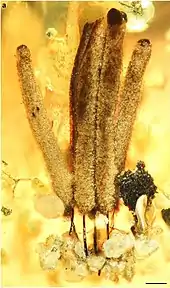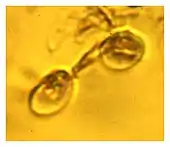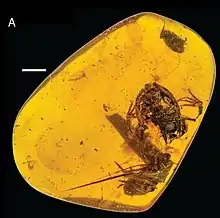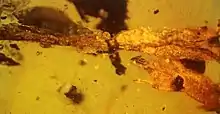Paleobiota of Burmese amber
Burmese amber is fossil resin dating to the early Late Cretaceous Cenomanian age recovered from deposits in the Hukawng Valley of northern Myanmar. It is known for being one of the most diverse Cretaceous age amber paleobiotas, containing rich arthropod fossils, along with uncommon vertebrate fossils and even rare marine inclusions. A mostly complete list of all taxa described up until 2018 can be found in Ross 2018;[1] its supplement Ross 2019b covers most of 2019.[2]
Amoebozoa
Dictyostelia
| Taxon | Authority | Year described | Notes | image |
|---|---|---|---|---|
|
Paleoplastes burmanica[3] |
Poinar & Vega |
2020 |
A possible dictyostelid slime mould |
|
Myxogastria
| Taxon | Authority | Year described | Notes | image |
|---|---|---|---|---|
|
N/A |
"2019" |
A myxogastrid slime mould |
|
Incertae sedis
| Taxon | Authority | Year described | Notes | image |
|---|---|---|---|---|
|
Endamoebites proterus[5] |
Poinar |
2009 |
A "Sarcodina" gut Amoebozoa of Kachinitermopsis burmensis |
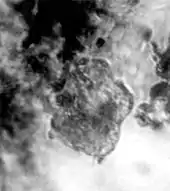 Endamoebites proterus |
Apicomplexa
Haemosporida
| Taxon | Authority | Year described | Notes | image |
|---|---|---|---|---|
|
Paleohaemoproteus burmacis[6] |
Poinar & Telford |
2005 |
A plasmodiid apicomplexan |
 Paleohaemoproteus burmacis oocyst |
Eugregarinorida
| Taxon | Authority | Year described | Notes | image |
|---|---|---|---|---|
|
Primigregarina burmanica[7] |
Poinar |
2010 |
A eugregarinorid apicomplexen gut protozoan of blattodeans |
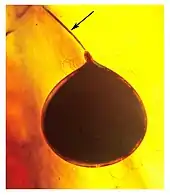 Primigregarina burmanica |
Euglenozoa
Trypanosomatida
| Taxon | Authority | Year described | Notes | image |
|---|---|---|---|---|
|
Poinar |
2004 |
A trypanosomatid vector in Palaeomyia burmitis |
| |
|
Paleotrypanosoma burmanicus[8] |
Poinar |
2008 |
A trypanosomatid vector in Leptoconops nosopheris |
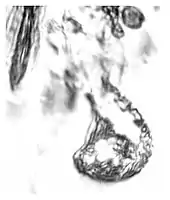 Paleotrypanosoma burmanicus in Leptoconops nosopheris saliva |
Metamonada
Oxymonadida
| Taxon | Authority | Year described | Notes | image |
|---|---|---|---|---|
|
Dinenymphites spiris[5] |
Poinar |
2009 |
A pyrsonymphid gut protozoan of Kachinitermopsis burmensis |
 Dinenymphites spiris |
|
Microrhopalodites polynucleatis[5] |
Poinar |
2009 |
An oxymonadid gut protozoan of Kachinitermopsis burmensis |
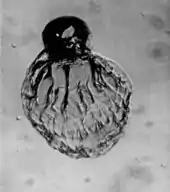 Microrhopalodites polynucleatis |
|
Oxymonas gigantea[9] |
Poinar |
2009 |
An oxymonadid gut protozoan of Blattarians |
|
|
Oxymonas protus[5] |
Poinar |
2009 |
An oxymonadid gut protozoan of Kachinitermopsis burmensis |
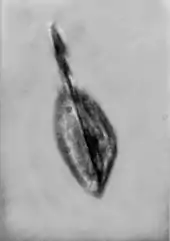 Oxymonas protus |
|
Oxymonites gerus[5] |
Poinar |
2009 |
An oxymonadid gut protozoan of Kachinitermopsis burmensis |
 Oxymonites gerus |
|
Pyrsonymphites cordylinis[5] |
Poinar |
2009 |
A pyrsonymphid gut protozoan of Kachinitermopsis burmensis |
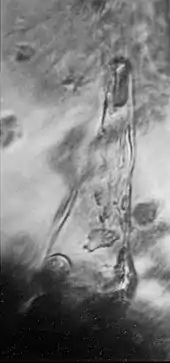 Pyrsonymphites cordylinis |
|
Sauromonites katatonis[5] |
Poinar |
2009 |
An oxymonadid gut protozoan of Kachinitermopsis burmensis |
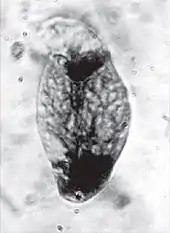 Sauromonites katatonis |
Trichonymphida
| Taxon | Authority | Year described | Notes | image |
|---|---|---|---|---|
|
Burmanymphus cretacea[9] |
Poinar |
2009 |
A burmanymphid gut protozoan of Blattarians |
|
|
Teranymphites rhabdotis[5] |
Poinar |
2009 |
A teranymphid gut protozoan of Kachinitermopsis burmensis |
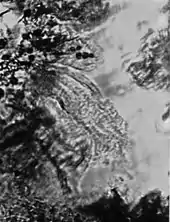 Teranymphites rhabdotis |
|
Trichonymphites henis[5] |
Poinar |
2009 |
A trichonymphid gut protozoan of Kachinitermopsis burmensis |
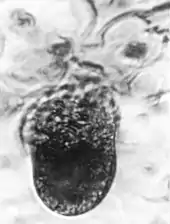 Trichonymphites henis |
Cristamonadida
| Taxon | Authority | Year described | Notes | image |
|---|---|---|---|---|
|
Devescovites proteus[9] |
Poinar |
2009 |
A devescovinid gut protozoan of Blattarians |
|
|
Foainites icelus[9] |
Poinar |
2009 |
A devescovinid gut protozoan of Blattarians |
|
Spirotrichonymphida
| Taxon | Authority | Year described | Notes | image |
|---|---|---|---|---|
|
Spiromastigites acanthodes[5] |
Poinar |
2009 |
A holomastigotid gut protozoan of Kachinitermopsis burmensis |
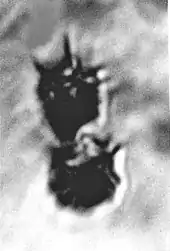 Spiromastigites acanthodes |
Trichomonadida
| Taxon | Authority | Year described | Notes | image |
|---|---|---|---|---|
|
Paleotrichomones burmanicus[9] |
Poinar |
2009 |
A trichomonadid gut protozoan of Blattarians |
|
"Opisthokonta"
Eccrinales
| Taxon | Authority | Year described | Notes | image |
|---|---|---|---|---|
|
Paleocadus burmiticus[10] |
Poinar |
2016 |
An eccrinacious Opisthokont |
|
Proteobacteria
Rickettsiales
| Taxon | Authority | Year described | Notes | image |
|---|---|---|---|---|
|
Palaeorickettsia protera[11] |
Poinar |
2014 |
A Rickettsiaceae in Cornupalpatum burmanicum vector |
 Palaeorickettsia protera |
Plants
Cornales
| Taxon | Authority | Year described | Notes | image |
|---|---|---|---|---|
|
Eoëpigynia burmensis[12] |
Poinar, Chamber & Buckley |
2007 |
A cornalean flower |
|
Laurales
| Taxon | Authority | Year described | Notes | image |
|---|---|---|---|---|
|
Cascolaurus burmitis[13] |
Poinar |
2017 |
A lauracious angiosperm |
|
|
Dispariflora robertae[14] |
Poinar & Chambers |
2019 |
A possible lauralean flower |
|
|
Jamesrosea burmensis[15] |
Crepet et al |
2016 |
A mosaic laralean genus |
|
| Palaeoanthella huangii[16] |
Poinar & Chambers |
2005 |
A possible monimiacious angiosperm |
|
|
Zygadelphus aetheus[17] |
Poinar & Chambers |
2019 |
A possible lauralian of uncertain phylogenetic placement |
|
Nymphaeales
| Taxon | Authority | Year described | Notes | image |
|---|---|---|---|---|
|
Praenymphaeapollenites cenomaniensis[18] |
Barrón, Peris & Labandeira |
2020 |
Pollen of a member of Nymphaeaceae. |
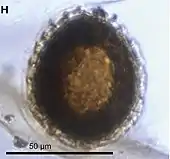 Praenymphaeapollenites cenomaniensis |
Oxalidales
| Taxon | Authority | Year described | Notes | image |
|---|---|---|---|---|
|
Tropidogyne lobodisca[19] |
Poinar & Chambers |
2019 |
A cunoniacious angiosperm. |
|
|
Tropidogyne pentaptera[20] |
Poinar & Chambers |
2017 |
A cunoniacious angiosperm. |
|
|
Tropidogyne pikei[21] |
Chambers, Poinar & Buckley |
2010 |
A cunoniacious angiosperm. |
|
Poales
| Taxon | Authority | Year described | Notes | image |
|---|---|---|---|---|
|
Programinis burmitis[22] |
Poinar |
2004 |
A poalean of uncertain placement |
|
|
Programinis laminatus[22] |
Poinar |
2004 |
A poalean of uncertain placement |
|
Incertae sedis
| Taxon | Authority | Year described | Notes | image |
|---|---|---|---|---|
|
Antiquifloris latifibris[23] |
Poinar, Buckley & Chen |
2016 |
An angiosperm of uncertain placement |
|
|
Chenocybus allodapus[24] |
Poinar |
2018 |
An angiosperm of uncertain placement |
|
|
Exalloanthum burmense[24] |
Poinar |
2018 |
An angiosperm of uncertain placement, |
|
|
Lachnociona terriae[26] |
Poinar, Chambers & Buckley |
2008 |
An angiosperm of uncertain placement |
|
|
Lijinganthus revoluta[27] |
Liu et al. |
2018 |
A core eudicot of uncertain placement |
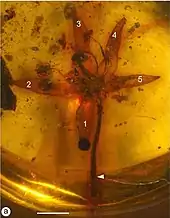 Lijinganthus revoluta |
|
Micropetasos burmensis[28] |
Poinar |
2004 |
An angiosperm of uncertain placement |
|
|
Rasenganus auricularus[29] |
Xing & Gu |
2020 |
A possible epizoochorous fruit. |
|
|
Strombothelya monostyla[30] |
Poinar & Chambers |
2019 |
An angiosperm of uncertain phylogenetic placement |
|
|
Strombothelya grammogyna[30] |
Poinar & Chambers |
2019 |
An angiosperm of uncertain phylogenetic placement |
|
Dicranales
| Taxon | Authority | Year described | Notes | image |
|---|---|---|---|---|
|
Calymperites burmensis[31] |
Heinrichs et al |
2014 |
A Dicranales moss of uncertain placement |
|
Hypnodendrales
| Taxon | Authority | Year described | Notes | image |
|---|---|---|---|---|
|
Vetiplanaxis espinosus[32] |
Hedenäs, Heinrichs, & Schmidt |
2014 |
One of four species described from Burmese amber |
|
|
Vetiplanaxis longiacuminatus[32] |
Hedenäs, Heinrichs, & Schmidt |
2014 |
One of four species described from Burmese amber |
|
|
Vetiplanaxis oblongus[32] |
Hedenäs, Heinrichs, & Schmidt |
2014 |
One of four species described from Burmese amber |
|
|
Vetiplanaxis pyrrhobryoides[32] |
Bell |
2007 |
One of three species described from Burmese amber |
|
Chaetophorales
| Taxon | Authority | Year described | Notes | image |
|---|---|---|---|---|
|
Electrophycus astroplethus[33] |
Poinar & Brown |
2020 |
A chaetophorale green algae |
|
Chlamydomonadales
| Ichnotaxon | Authority | Year described | Notes | image |
|---|---|---|---|---|
|
Chlamydomonas hanublikanus[34] |
Hinkelman & Vršanská |
2020 |
A chlamydomonadaceous green algae. |
|
Porellales
| Taxon | Authority | Year described | Notes | image |
|---|---|---|---|---|
|
Frullania baerlocheri[35] |
Heinrichs et al |
2011 |
A frullaniacious liverwort |
|
|
Frullania cretacea[36] |
Hentschel, Schmidt & Heinrichs |
2009 |
A frullaniacious liverwort |
|
|
Frullania partita[37] |
Li et al. |
2020 |
A frullaniacious liverwort |
|
|
Frullania pinnata[38] |
Heinrichs, Feldberg, Schäfer-Verwimpe, & Krings |
2017 |
A frullaniacious liverwort |
|
|
Gackstroemia cretacea[39] |
Heinrichs, Schäfer-Verwimp, Feldberg, & A.R. Schmidt |
2017 |
A lepidolaenacious liverwort |
|
|
Protofrullania cornigera[40] |
Heinrichs |
2017 |
A frullaniacious liverwort |
|
|
Radula cretacea[41] |
Bechteler, M.A.M. Renner, Schäfer-Verwimp, & Heinrichs |
2017 |
A Radulaceae liverwort |
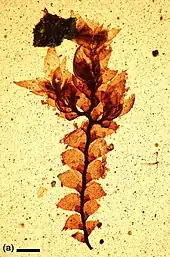 Radula cretacea |
Cyatheales
| Taxon | Authority | Year described | Notes | image |
|---|---|---|---|---|
|
Thyrsopteris cretacea[42] |
Li et al. |
2020 |
A thyrsopteridacious tree-fern |
|
Polypodiales
| Taxon | Authority | Year described | Notes | image |
|---|---|---|---|---|
|
Cretacifilix fungiformis[43] |
Poinar & Buckley |
2008 |
A eupolypod fern |
|
|
Cystodium sorbifolioides[44] |
Regalado et al |
2017 |
A Cystodiacious fern |
 Cystodium sorbifolioides |
|
Heinrichsia cheilanthoides[45] |
Regalado, Schmidt, Krings & Schneider |
2019 |
A pteridacious fern |
|
|
Holttumopteris burmensis[46] |
Regalado, Schneider, Krings, & Heinrichs |
2018 |
A fern of uncertain placement |
|
|
Krameropteris resinatus[47] |
Schneider, Smith, & Heinrichs |
2016 |
A dennstaedtiacious fern |
|
|
Proodontosoria myanmarensis[48] |
Li et al. |
2020 |
A lindsaeacious fern |
|
Fungi
Hypocreales
| Taxon | Authority | Year described | Notes | image |
|---|---|---|---|---|
|
Poinar & Buckley |
2007 |
A hypermycoparasitic fungus |
||
|
Poinar & Buckley |
2007 |
A hypermycoparasitic fungus |
||
|
Palaeoclaviceps parasiticus[50] |
Poinar, Alderman & Wunderlich |
2015 |
An ergot |
|
|
Paleoophiocordyceps coccophagus[51] |
Sung, Poinar & Spatafora |
2008 |
A parasite of a scale insect |
|
Ophiostomatales
| Taxon | Authority | Year described | Notes | image |
|---|---|---|---|---|
|
Paleoambrosia entomophila[52] |
Poinar & Vega |
2018 |
An ambrosia fungus associated with Palaeotylus femoralis. |
 Paleoambrosia entomophila |
Agaricales
| Taxon | Authority | Year described | Notes | image |
|---|---|---|---|---|
|
Poinar & Buckley |
2007 |
An agaricale of uncertain placement |
| |
Boletales
| Taxon | Authority | Year described | Notes | image |
|---|---|---|---|---|
|
Palaeogaster micromorpha[53] |
Poinar, Alfredo & Baseia |
2014 |
A Boletale fungus |
 Palaeogaster micromorpha |
incertae sedis
| Taxon | Authority | Year described | Notes | image |
|---|---|---|---|---|
|
Palaeomycus epallelus[54] |
Poinar |
2018 |
A Pezizomycotina fungi |
|
|
Spheciophila adercia[55] |
Poinar |
2016 |
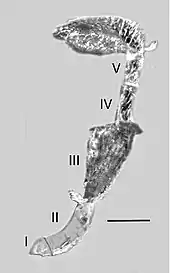 Spheciophila adercia | |
Priscadvenales
| Taxon | Authority | Year described | Notes | image |
|---|---|---|---|---|
|
Priscadvena corymbosa[56] |
Poinar & Vega |
2019 |
A trichomycete |
 Priscadvena corymbosa |
Echinodermata
Isocrinida
| Taxon | Authority | Year described | Notes | image |
|---|---|---|---|---|
|
Isocrinus cf. legeri[57] |
Salamon et al. |
2019 |
An Isocrinid crinoid, described from ossicles encased in the resin |
|
Arthropoda
Amblypygi
| Taxon | Authority | Year described | Notes | image |
|---|---|---|---|---|
|
Burmacharon dunlopi[58] |
Hu et al. |
2020 |
||
|
Kronocharon engeli[59] |
Wunderlich |
2015 |
A tailless whip scorpion of uncertain placement. |
|
|
Kronocharon longicalcaris[59] |
Wunderlich |
2015 |
A tailless whip scorpion of uncertain placement. |
|
|
Kronocharon prendinii[60] |
Rossi & Merendino |
2016 |
A tailless whip scorpion of uncertain placement. |
|
Araneae
| Taxon | Authority | Year described | Notes | image |
|---|---|---|---|---|
|
Aculeatosoma pyritmutatio[62] |
Wunderlich |
2017 |
||
|
Albiburmops annulipes[62] |
Wunderlich |
2017 |
||
|
Aliendiguetia praecursor[63] |
Wunderlich & Müller |
2020 |
A spider of uncertain phylogenetic placement, possibly related to the Ochyroceratoidea. |
|
|
Wunderlich |
2017 |
|||
|
Alteraraneus gracilipes[65] |
Wunderlich in Wunderlich & Müller |
2018 |
A zarqaraneid spider. |
|
|
Alteruloborus araneoides[65] |
Wunderlich in Wunderlich & Müller |
2018 |
An alteruloborid spider. |
|
|
Archaelagonops propinquus[66] |
Wunderlich |
2015 |
||
|
Archaelagonops salticoides[67] |
Wunderlich |
2012 |
||
|
Archaelagonops scorsum[66] |
Wunderlich |
2015 |
||
|
Autotomiana hirsutipes[66] |
Wunderlich |
2015 |
A Pholcochyrocerid spider. |
|
|
Biapophyses beate[66] |
Wunderlich |
2015 |
A praeterleptonetid spider. |
|
|
Bicalamistrum mixtum[66] |
Wunderlich |
2015 |
||
|
Bicornoculus granulans[63] |
Wunderlich & Müller |
2020 |
An armored spider. |
|
|
Bicornoculus levis[66] |
Wunderlich |
2015 |
An armored spider. |
|
|
Burlagonomegops eskovi[68] |
Penny |
2005 |
||
|
Burmadictyna clava[66] |
Wunderlich |
2015 |
||
|
Burmadictyna excavata[66] |
Wunderlich |
2015 |
||
|
Burmadictyna pectin[69] |
Wunderlich |
2008 |
||
|
Burmadictyna postcopula[62] |
Wunderlich |
2017 |
||
|
Burmaforceps amputatus[65] |
Wunderlich in Wunderlich & Müller |
2018 |
A zarqaraneid spider. |
|
|
Burmascutum aenigma[69] |
Wunderlich |
2008 |
A burmascutid spider. |
|
|
Burmascutum brevis[65] |
Wunderlich |
2018 |
A burmascutid spider. |
|
|
Burmasuccinus bulla[65] |
Wunderlich in Wunderlich & Müller |
2018 |
A uloborid spider. |
|
|
Burmathele biseriata[62] |
Wunderlich |
2017 |
A burmathelid mesothele spider. |
|
|
Burmatheridion sinespinae[65] |
Wunderlich in Wunderlich & Müller |
2018 |
A theridiid spider. |
|
|
Burmesarchaea alissa[62] |
Wunderlich |
2017 |
An archaeid spider |
|
|
Burmesarchaea bilongapophyses[63] |
Wunderlich & Müller |
2020 |
An archaeid spider. |
|
|
Burmesarchaea caudata[62] |
Wunderlich |
2017 |
An archaeid spider |
|
|
Burmesarchaea crassicaput [62] |
Wunderlich |
2017 |
An archaeid spider |
|
|
Burmesarchaea crassichelae[62] |
Wunderlich |
2017 |
An archaeid spider |
|
|
Burmesarchaea gibber[62] |
Wunderlich |
2017 |
An archaeid spider |
|
|
Burmesarchaea gibberoides[62] |
Wunderlich |
2017 |
An archaeid spider |
|
|
Burmesarchaea gibbosa[62] |
Wunderlich |
2017 |
An archaeid spider |
|
|
(Penny) |
2003 |
An archaeid spider, |
||
|
Burmesarchaea longicollum[62] |
Wunderlich |
2017 |
An archaeid spider |
|
|
Burmesarchaea propinqua[62] |
Wunderlich |
2017 |
An archaeid spider |
|
|
Burmesarchaea pseudogibber[62] |
Wunderlich |
2017 |
An archaeid spider |
|
|
Burmesarchaea pustulata[62] |
Wunderlich |
2017 |
An archaeid spider |
|
|
Burmesarchaea quadrata[62] |
Wunderlich |
2017 |
An archaeid spider |
|
|
Burmesarchaea speciosa[62] |
(Wunderlich) |
2008 |
An archaeid spider, |
|
|
Burmesia sordida[63] |
Wunderlich & Müller |
2020 |
A member of the family Nemesiidae. |
|
|
Burmesiola cretacea[70] |
Wunderlich |
2011 |
A tree trunk spider. |
|
|
Burmesiola daviesi[66] |
Wunderlich |
2015 |
A tree trunk spider. |
|
|
?Burmesiola kachinensis[63] |
Wunderlich & Müller |
2020 |
A tree trunk spider. |
|
|
Burmorchestina acuminata[62] |
Wunderlich |
2017 |
||
|
Burmorchestina biangulata[62] |
Wunderlich |
2017 |
||
|
Burmorchestina circular[63] |
Wunderlich & Müller |
2020 |
A goblin spider. |
|
|
Burmorchestina plana[62] |
Wunderlich |
2017 |
||
|
Burmorchestina pulcher[69] |
Wunderlich |
2008 |
||
|
Burmorchestina pulcheroides[62] |
Wunderlich |
2017 |
||
|
Burmorchestina tuberosa[62] |
Wunderlich |
2017 |
||
|
Wunderlich |
2015 |
Transferred to the separate genus Pseudorsolus in 2017, but moved back to the genus Burmorsolus in 2020. |
||
|
(Wunderlich) |
2017 |
Originally described as "Loxoderces" curvatus. |
||
|
Burmorsolus globosus[63] |
Wunderlich & Müller |
2020 |
||
|
Burmorsolus longembolus[63] |
Wunderlich & Müller |
2020 |
||
|
Burmorsolus longibulbus[63] |
Wunderlich & Müller |
2020 |
||
|
(Wunderlich) |
2017 |
Originally described as "Loxoderces" longicymbium. |
||
|
Burmorsolus nonplumosus[66] |
Wunderlich |
2015 |
Probably a relative of trogloraptorids.[63] |
|
|
(Wunderlich) |
2017 |
Originally described as "Loxoderces" rectus. |
||
|
Burmuloborus antefixus[66] |
Wunderlich |
2015 |
||
|
Burmuloborus parvus[69] |
Wunderlich |
2008 |
||
|
?Burmuloborus prolongatus[66] |
Wunderlich |
2015 |
A cribellate orb weaver of uncertain placement. |
|
|
Cethegoides patricki[62] |
Wunderlich |
2017 |
||
|
Converszarqaraneus annulipedes[65] |
Wunderlich in Wunderlich & Müller |
2018 |
A zarqaraneid spider. |
|
|
Cornicaraneus scutatus[65] |
Wunderlich in Wunderlich & Müller |
2018 |
A zarqaraneid spider. |
|
|
Crassitibia baculum[65] |
Wunderlich in Wunderlich & Müller |
2018 |
A zarqaraneid spider. |
|
|
Crassitibia longispina[66] |
Wunderlich |
2015 |
A zarqaraneid spider. |
|
|
Crassitibia tenuimana[66] |
Wunderlich |
2015 |
A zarqaraneid spider. |
|
|
Cretaceothele lata[66] |
Wunderlich |
2015 |
A cretaceothelid Mesothelaen spider.[62] |
|
|
Cretamysmena fontana[65] |
Wunderlich in Wunderlich & Müller |
2018 |
A cretamysmenid spider. |
|
|
Cretotheridion inopinatum[66] |
Wunderlich |
2015 |
||
|
Curvitibia curima[66] |
Wunderlich |
2015 |
A zarqaraneid spider.[65] The type species is Curvitibia . |
|
|
Cymbioblemma corniger[62] |
Wunderlich |
2017 |
An armored spider. |
|
|
Cymbioblemma fusca[63] |
Wunderlich & Müller |
2020 |
An armored spider. |
|
|
Cymbioblemma hamoembolus[63] |
Wunderlich & Müller |
2020 |
An armored spider. |
|
|
Cymbiolagonops cymbiocalcar[66] |
Wunderlich |
2015 |
||
|
Wunderlich |
2017 |
|||
|
Electroblemma bifida[71] |
Selden, Zhang & Ren |
2016 |
A tetrablemmid armored spider. |
|
|
Electroblemma bifurcata[63] |
Wunderlich & Müller |
2020 |
An armored spider. |
|
|
(Wunderlich) |
2017 |
An armored spider. |
||
|
Electroblemma caula[63] |
Wunderlich & Müller |
2020 |
An armored spider. |
|
|
(Wunderlich) |
2017 |
An armored spider. |
||
|
(Wunderlich) |
2017 |
An armored spider. |
||
|
Electroblemma pinnae[63] |
Wunderlich & Müller |
2020 |
An armored spider. |
|
|
Eodeinopis longipes[62] |
Wunderlich |
2017 |
A Burmadictynid stem-deinopoid spider. |
|
|
?Eogamasomorpha clara[66] |
Wunderlich |
2015 |
An armored spider of uncertain generic placement. |
|
|
Eogamasomorpha hamata[62] |
Wunderlich |
2017 |
An armored spider. |
|
|
Eogamasomorpha nubila[69] |
Wunderlich |
2008 |
||
|
Eogamasomorpha ohlhoffi[62] |
(Wunderlich) |
2011 |
An armored spider. |
|
|
Eogamasomorpha rostratis[63] |
Wunderlich & Müller |
2020 |
An armored spider. |
|
|
Eomesothele noninclinata[72] |
Wunderlich |
2019 |
An eomesothelid spider. |
|
|
Eomysmauchenius dubius[62] |
Wunderlich |
2017 |
An archaeid spider |
|
|
?Eomysmauchenius longissipes |
(Wunderlich) |
2015 |
An archaeid spider, |
|
|
Eomysmauchenius septentrionalis[62] |
Wunderlich |
2008 |
An archaeid spider |
|
|
Eopsiloderces filiformis[67] |
Wunderlich |
2012 |
An eopsilodercid spider. |
|
|
Eopsiloderces loxosceloides[69] |
Wunderlich |
2008 |
An eopsilodercid spider. |
|
|
Eopsiloderces serenitas[66] |
Wunderlich |
2015 |
An eopsilodercid spider. |
|
|
Eotibiaapophysis reliquus[65] |
Wunderlich in Wunderlich & Müller |
2018 |
A uloborid spider. |
|
|
Wunderlich |
2015 |
|||
|
Frateruloborus bulbosus[65] |
Wunderlich in Wunderlich & Müller |
2018 |
A frateruloborid spider. |
|
|
Furcembolus andersoni[69] |
Wunderlich |
2008 |
An armored spider. |
|
|
Furcembolus armatura[62] |
(Wunderlich) |
2015 |
An armored spider. |
|
|
Furcembolus biacuta[62] |
(Wunderlich) |
2015 |
An armored spider. |
|
|
Furcembolus crassitibia[62] |
Wunderlich |
2017 |
An armored spider. |
|
|
Furcembolus dissolata[62] |
(Wunderlich) |
2015 |
An armored spider. |
|
|
Furcembolus equester[62] |
(Wunderlich) |
2015 |
An armored spider. |
|
|
Furcembolus grossa[62] |
Wunderlich |
2017 |
An armored spider. |
|
|
Furcembolus longior[62] |
Wunderlich |
2017 |
An armored spider. |
|
|
Furcembolus tuberosa[62] |
(Wunderlich) |
2015 |
An armored spider. |
|
|
Furculoborus patellaris[62] |
Wunderlich |
2017 |
||
|
Groehnianus burmensis[66] |
Wunderlich |
2015 |
A zarqaraneid spider.[65] |
|
|
Hamoderces opilionoides[63] |
Wunderlich & Müller |
2020 |
A spider belonging to the superfamily Scytodoidea and the family Praepholcidae. |
|
|
Hypotheridiosoma paracymbium[67] |
Wunderlich |
2012 |
A zarqaraneid spider.[65] |
|
|
Intermesothele pulcher[72] |
Wunderlich |
2019 |
An eomesothelid spider. |
|
|
Kachin fruticosoides[62] |
Wunderlich |
2017 |
||
|
Kachin fruticosus[62] |
Wunderlich |
2017 |
||
|
Kachin serratus[65] |
Wunderlich |
2018 |
||
|
Lagonoburmops plumosus[67] |
Wunderlich |
2012 |
||
|
?Lagonomegops tuber[66] |
Wunderlich |
2015 |
A lagonomegopid spider of uncertain generic placement. |
|
|
Leviunguis altus[65] |
Wunderlich in Wunderlich & Müller |
2018 |
A leviunguid spider. |
|
|
Leviunguis anulus[65] |
Wunderlich in Wunderlich & Müller |
2018 |
A leviunguid spider. |
|
|
Leviunguis anulusoides[65] |
Wunderlich in Wunderlich & Müller |
2018 |
A leviunguid spider. |
|
|
Leviunguis bruckschi[67] |
Wunderlich |
2012 |
A leviunguid spider.[65] |
|
|
Leviunguis bruckschoides[65] |
Wunderlich in Wunderlich & Müller |
2018 |
A leviunguid spider. |
|
|
Leviunguis erectus[65] |
Wunderlich in Wunderlich & Müller |
2018 |
A leviunguid spider. |
|
|
Leviunguis glomulus[65] |
Wunderlich in Wunderlich & Müller |
2018 |
A leviunguid spider. |
|
|
Leviunguis glomus[65] |
Wunderlich in Wunderlich & Müller |
2018 |
A leviunguid spider. |
|
|
Leviunguis graciliembolus[65] |
Wunderlich in Wunderlich & Müller |
2018 |
A leviunguid spider. |
|
|
Leviunguis gradus[65] |
Wunderlich in Wunderlich & Müller |
2018 |
A leviunguid spider. |
|
|
Leviunguis porrigens[65] |
Wunderlich in Wunderlich & Müller |
2018 |
A leviunguid spider. |
|
|
Leviunguis pseudobruckschi[65] |
Wunderlich in Wunderlich & Müller |
2018 |
A leviunguid spider. |
|
|
Leviunguis quadratus[65] |
Wunderlich in Wunderlich & Müller |
2018 |
A leviunguid spider. |
|
|
Lineaburmops beigeli[66] |
Wunderlich |
2015 |
||
|
Lineaburmops hirsutipes[66] |
Wunderlich |
2015 |
||
|
Lineaburmops maculatus[62] |
Wunderlich |
2017 |
||
|
Longissipalpus cochlea[62] |
Wunderlich |
2017 |
||
|
Longissipalpus magnus[66] |
Wunderlich |
2015 |
||
|
Longissipalpus maior[66] |
Wunderlich |
2015 |
||
|
Longissipalpus minor[66] |
Wunderlich |
2015 |
||
|
Longissithorax myanmarensis[62] |
Wunderlich |
2017 |
An armored spider. |
|
|
Longithorax furca[62] |
Wunderlich |
2017 |
An armored spider. |
|
|
Magnosegestria tuber[63] |
Wunderlich & Müller |
2020 |
Probably a tube-dwelling spider. |
|
|
Micropalpimanus poinari[69] |
Wunderlich |
2008 |
A micropalpimanid palpimanoid spider |
|
|
Microproxiaraneus annulatus[65] |
Wunderlich in Wunderlich & Müller |
2018 |
A zarqaraneid spider. |
|
|
Microuloborus birmanicus[66] |
Wunderlich |
2015 |
||
|
Myanlagonops gracilipes[67] |
Wunderlich |
2012 |
||
|
Myannemesia glaber[63] |
Wunderlich & Müller |
2020 |
A member of the family Nemesiidae. |
|
|
Myansegestria caederens[66] |
Wunderlich |
2015 |
||
|
Myansegestria engin[66] |
Wunderlich |
2015 |
||
|
Nephila burmanica[73] |
Poinar |
2012 |
A nephiline spider |
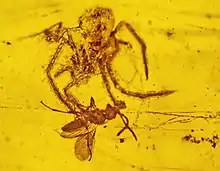 Nephila burmanica |
|
Ocululoborus curvatus[67] |
Wunderlich |
2012 |
||
|
Odontomegops titan[75] |
Guo et al. |
2020 |
A lagonomegopid spider |
|
|
Palaeohygropoda myanmarensis[76] |
Penny |
2004 |
A palaeohygropodine praeterleptonetid spider |
|
|
Palaeoleptoneta calcar[67] |
Wunderlich |
2012 |
A leptonetid spider. |
|
|
Palaeoleptoneta crus[62] |
Wunderlich |
2017 |
A leptonetid spider. |
|
|
Palaeoleptoneta nils[65] |
Wunderlich in Wunderlich & Müller |
2018 |
A leptonetid spider. |
|
|
Palaeoleptoneta thilo[65] |
Wunderlich in Wunderlich & Müller |
2018 |
A leptonetid spider. |
|
|
Palaeomiagrammopes vesica[69] |
Wunderlich |
2008 |
||
|
Palazarqaraneus hamulus[63] |
Wunderlich & Müller |
2020 |
A zarqaraneid spider. |
|
|
Palpalpaculla pulcher[62] |
Wunderlich |
2017 |
An armored spider. |
|
|
Paramiagrammopes cretaceus[69] |
Wunderlich |
2008 |
||
|
Paramiagrammopes longiclypeus[66] |
Wunderlich |
2015 |
||
|
Paramiagrammopes patellidens[66] |
Wunderlich |
2015 |
||
|
Paramiagrammopes pusillus[65] |
Wunderlich in Wunderlich & Müller |
2018 |
||
|
Parvibulbus incompletus[65] |
Wunderlich in Wunderlich & Müller |
2018 |
A pholcochyrocerid. |
|
|
Parviburmops brevipalpus[66] |
Wunderlich |
2015 |
||
|
Parvispina tibialis[66] |
(Wunderlich) |
2011 |
A zarqaraneid spider.[65] |
|
|
Parvithele muelleri[62] |
Wunderlich |
2017 |
A parvithelid mesothelaen spider. |
|
|
Parvithele spinipes[62] |
Wunderlich |
2017 |
A parvithelid mesothelaen spider. |
|
|
Parvocteniza parvula[63] |
Wunderlich & Müller |
2020 |
A member of the family Ctenizidae. |
|
|
Parvosegestria longitibialis[66] |
Wunderlich |
2015 |
||
|
Parvosegestria obscura[66] |
Wunderlich |
2015 |
||
|
Parvosegestria pintgu[66] |
Wunderlich |
2015 |
||
|
(Wunderlich) |
2015 |
Originally described as "Denticulsegestria" rugosa. |
||
|
Parvosegestria triplex[66] |
Wunderlich |
2015 |
||
|
Paurospina curvata[65] |
Wunderlich in Wunderlich & Müller |
2018 |
A zarqaraneid spider. |
|
|
Paurospina fastigata[63] |
Wunderlich & Müller |
2020 |
A zarqaraneid spider. |
|
|
Paurospina fortis[65] |
Wunderlich in Wunderlich & Müller |
2018 |
A zarqaraneid spider. |
|
|
Paurospina paulocurvata[65] |
Wunderlich in Wunderlich & Müller |
2018 |
A zarqaraneid spider. |
|
|
?Paxillomegops cornutus[62] |
Wunderlich |
2017 |
A lagonomegopid spider of uncertain generic placement. |
|
|
?Paxillomegops brevipes[66] |
Wunderlich |
2015 |
A lagonomegopid spider of uncertain generic placement. |
|
|
Paxillomegops longipes[66] |
Wunderlich |
2015 |
||
|
Pedipalparaneus seldeni[66] |
Wunderlich |
2015 |
||
|
Pekkachilus vesica[62] |
Wunderlich |
2017 |
A vetiatorid spider. |
|
|
Pholcochyrocer altipecten[62] |
Wunderlich |
2017 |
A pholcochyrocerid spider. |
|
|
?Pholcochyrocer baculum[67] |
Wunderlich |
2012 |
A pholcochyrocerid spider of uncertain generic placement |
|
|
Pholcochyrocer calidum[65] |
Wunderlich in Wunderlich & Müller |
2018 |
A pholcochyrocerid spider. |
|
|
Pholcochyrocer guttulaeque[69] |
Wunderlich |
2008 |
A pholcochyrocerid spider. |
|
|
Pholcochyrocer pecten[67] |
Wunderlich |
2012 |
A pholcochyrocerid spider. |
|
|
Pholcochyrocer vermiculus[65] |
Wunderlich in Wunderlich & Müller |
2018 |
A pholcochyrocerid spider. |
|
|
Phyxioschemoides collembola[66] |
Wunderlich |
2015 |
||
|
Picturmegops signatus[66] |
Wunderlich |
2015 |
||
|
Planarchaea kopp[66] |
Wunderlich |
2015 |
||
|
Planarchaea oblonga[65] |
Wunderlich |
2017 |
An assassin spider. |
|
|
Planarchaea ovata[65] |
Wunderlich |
2017 |
An assassin spider. |
|
|
?Planarchaea paucidentata |
(Wunderlich) |
2008 |
An assassin spider, |
|
|
Planarchaea pilosa |
(Wunderlich) |
2015 |
An assassin spider spider, |
|
|
Planibulbus longisoma[65] |
Wunderlich in Wunderlich & Müller |
2018 |
A uloborid spider. |
|
|
Planimegops parvus[62] |
Wunderlich |
2017 |
||
|
Praearaneus araneoides[63] |
Wunderlich & Müller |
2020 |
A praearaneid spider. |
|
|
Praearaneus bruckschi[62] |
Wunderlich |
2017 |
A praearaneid spider. |
|
|
Praepholcus huberi[62] |
Wunderlich |
2017 |
An eopsilodercid spider. |
|
|
Praeteraneoides bifurcatum[65] |
Wunderlich in Wunderlich & Müller |
2018 |
A protoaraneoidid spider. |
|
|
Praeteraneoides bipartitum[65] |
Wunderlich in Wunderlich & Müller |
2018 |
A protoaraneoidid spider. |
|
|
Praeteraneoides leni[65] |
Wunderlich in Wunderlich & Müller |
2018 |
A protoaraneoidid spider. |
|
|
Praeterleptoneta spinipes[69] |
Wunderlich |
2008 |
A Praeterleptonetine praeterleptonetid spider |
|
|
Priscaleclercera brevispinae[62] |
Wunderlich |
2017 |
||
|
Priscaleclercera christae[77] |
Magalhaes et al. |
2021 |
A psilodercid spider. |
|
|
Priscaleclercera ellenbergeri[62] |
(Wunderlich) |
2015 |
A psilodercid spider. |
|
|
Priscaleclercera furcata[63] |
Wunderlich & Müller |
2020 |
A psilodercid spider. |
|
|
Priscaleclercera hamo[63] |
Wunderlich & Müller |
2020 |
A psilodercid spider. |
|
|
Priscaleclercera liber[63] |
Wunderlich & Müller |
2020 |
A psilodercid spider. |
|
|
Priscaleclercera longissipes[62] |
(Wunderlich) |
2012 |
A psilodercid spider. |
|
|
Priscaleclercera paucispinae[62] |
Wunderlich |
2017 |
||
|
Priscaleclercera sexaculeata[62] |
(Wunderlich) |
2015 |
A psilodercid spider. "Leclercera" sexaculeata.[66] |
|
|
Priscaleclercera spicula[62] |
(Wunderlich) |
2012 |
A psilodercid spider. "Leclercera" spicula.[67] |
|
|
Proaraneoides cribellatum[65] |
Wunderlich in Wunderlich & Müller |
2018 |
A protoaraneoidid spider. |
|
|
Propterkachin magnoculus[62] |
Wunderlich |
2017 |
||
|
Propterpsiloderces crassitibia[63] |
Wunderlich & Müller |
2020 |
An eopsilodercid spider. |
|
|
Propterpsiloderces cymbioseta[63] |
Wunderlich & Müller |
2020 |
An eopsilodercid spider. |
|
|
Propterpsiloderces duplex[63] |
Wunderlich & Müller |
2020 |
An eopsilodercid spider. |
|
|
Propterpsiloderces longisetae[66] |
Wunderlich |
2015 |
An eopsilodercid spider.[63] |
|
|
Protertheraphosa spinipes[63] |
Wunderlich & Müller |
2020 |
A tarantula. |
|
|
Protoaraneoides longispina[65] |
Wunderlich in Wunderlich & Müller |
2018 |
A protoaraneoidid spider. |
|
|
Proxiaraneus rarus[65] |
Wunderlich in Wunderlich & Müller |
2018 |
A zarqaraneid spider. |
|
|
Pulvillothele haupti[62] |
Wunderlich |
2017 |
A parvithelid mesothelaen spider. |
|
|
Ramozarqaraneus pauxillus[65] |
Wunderlich in Wunderlich & Müller |
2018 |
A zarqaraneid spider. |
|
|
Retrooecobius chomskyi[66] |
Wunderlich |
2015 |
||
|
Retrooecobius convexus[66] |
Wunderlich |
2015 |
||
|
Saetosoma filiembolus[67] |
Wunderlich |
2012 |
An armored spider. |
|
|
Spatiator putescens[66] |
Wunderlich |
2015 |
A spatiatorid spider. |
|
|
Spinasilia dissoluta[66] |
Wunderlich |
2015 |
A tree trunk spider. |
|
|
Spinicreber antiquus[66] |
Wunderlich |
2015 |
A pholcochyrocerid spider. |
|
|
Spinicreber vacuus[63] |
Wunderlich & Müller |
2020 |
A pholcochyrocerid spider. |
|
|
Spinicymbium curvimetatarsus[65] |
Wunderlich in Wunderlich & Müller |
2018 |
A zarqaraneid spider. |
|
|
Spinicymbium falcata[65] |
(Wunderlich) |
2015 |
A zarqaraneid spider. |
|
|
Spinipalpitibia hirsuta[65] |
Wunderlich in Wunderlich & Müller |
2018 |
A protoaraneoidid spider. |
|
|
Spinipalpitibia maior[66] |
Wunderlich |
2015 |
A protoaraneoidid spider. |
|
|
Spinipalpus vetus[66] |
Wunderlich |
2015 |
A pholcochyrocerid spider. |
|
|
Unicornutiblemma brevicornis[63] |
Wunderlich & Müller |
2020 |
An armored spider. |
|
|
Unicornutiblemma gracilicornis[63] |
Wunderlich & Müller |
2020 |
An armored spider. |
|
|
Unicornutiblemma longicornis[63] |
Wunderlich & Müller |
2020 |
An armored spider. |
|
|
(Wunderlich) |
2017 |
An armored spider. |
||
|
Uniscutosoma aberrans[66] |
Wunderlich |
2015 |
An armored spider. |
|
|
Vetiator gracilipes[66] |
Wunderlich |
2015 |
A vetiatorid spider.[62] |
|
|
Zamilia aculeopectens[66] |
Wunderlich |
2015 |
||
|
Zamilia antecessor[69] |
Wunderlich |
2008 |
||
|
Zamilia quattuormammillae[66] |
Wunderlich |
2015 |
||
Ixodida
| Taxon | Authority | Year described | Notes | image |
|---|---|---|---|---|
|
Amblyomma birmitum[78] |
Chitimia-Dobler et al. |
2017 |
An ixodid hard tick. |
|
|
Cornupalpatum burmanicum[79] |
Poinar & Brown |
2003 |
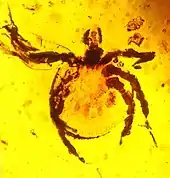 Cornupalpatum burmanicum | |
|
Deinocroton draculi[80] |
Peñalver, Arillo, Anderson & Pérez-de la Fuente |
2017 |
A deinocrotonid tick. |
|
|
Haemaphysalis (Alloceraea) cretacea[81] |
Chitimia-Dobler, Pfeffer & Dunlop |
2018 |
||
Opilioacariformes
| Taxon | Authority | Year described | Notes | image |
|---|---|---|---|---|
|
?Opilioacarus groehni[82] |
Dunlop & Bernardi |
2014 |
An opilioacarid mite. |
|
Opiliones
| Taxon | Authority | Year described | Notes | image |
|---|---|---|---|---|
|
Biungulus xiai[83] |
Bartel et al. |
2020 |
||
|
Ellenbergellus tuberculatus[83] |
Bartel et al. |
2020 |
A tithaeid harvestman. |
|
|
Gigantocheles nilsi[83] |
Bartel et al. |
2020 |
An epedanid armoured harvestman. |
|
|
Halitherses grimaldii[84] |
Giribet & Dunlop |
2005 |
||
|
Mesokanus oehmkuehnlei[83] |
Bartel et al. |
2020 |
A mesokanid laniatorean harvestman. |
|
|
Monooculricinuleus incisus[85] |
Wunderlich |
2017 |
A monooculricinuleid harvestman.[64] |
|
|
Monooculricinuleus semiglobosus[85] |
Wunderlich |
2017 |
A monooculricinuleid harvestman.[64] |
|
|
Palaeobeloniscus thilolebi[83] |
Bartel et al. |
2020 |
A beloniscid harvestman. |
|
|
Palaeosiro burmanicum[86] |
Poinar |
2008 |
||
|
Petrobunoides sharmai[87] |
Selden et al. |
2016 |
||
|
Protopyramidops nalae[83] |
Bartel et al. |
2020 |
Possibly a pyramidopid harvestman. |
|
Palpigradi
| Taxon | Authority | Year described | Notes | image |
|---|---|---|---|---|
|
Electrokoenenia yaksha[88] |
Engel & Huang |
2016 |
A Eukoeneniid microwhip scorpion |
|
Pseudoscorpiones
| Taxon | Authority | Year described | Notes | image |
|---|---|---|---|---|
|
Amblyolpium burmiticum[89] |
(Cockerell) |
1920 |
A garypinid pseudoscorpion. |
|
|
Electrobisium acutum[90] |
Cockerell |
1917 |
||
|
Procheiridium judsoni[91] |
Porta et al. |
2020 |
A cheiridiid pseudoscorpion. |
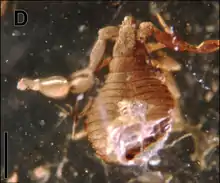 Procheiridium judsoni |
|
Protofeaella peetersae[92] |
Henderickx in Henderickx & Boone |
2016 |
A pseudoscorpion of uncertain placement.[93] |
|
|
Weygoldtiella plausus[94] |
Harvey et al. |
2018 |
||
Ricinulei
| Taxon | Authority | Year described | Notes | image |
|---|---|---|---|---|
|
Hirsutisoma acutiformis[85] |
Wunderlich |
2017 |
A Hirsutisomid hooded tickspider. |
|
|
Hirsutisoma bruckschi[85] |
Wunderlich |
2017 |
A Hirsutisomid hooded tickspider. |
|
|
Hirsutisoma dentata[85] |
Wunderlich |
2017 |
A Hirsutisomid hooded tickspider. |
|
|
?Poliochera cretacea[95] |
Wunderlich |
2012 |
A poliocherid hooded tickspider of uncertain generic placement. |
|
|
Primoricinuleus pugio[59] |
Wunderlich |
2015 |
A primoricinuleid hooded tickspider. |
|
Schizomida
| Taxon | Authority | Year described | Notes | image |
|---|---|---|---|---|
|
Mesozomus groehni[96] |
Müller et al. |
2020 |
A short-tailed whip scorpion |
|
Scorpiones
| Taxon | Authority | Year described | Notes | image |
|---|---|---|---|---|
|
Archaeoananteroides maderai[97] |
Lourenço & Velten |
2016 |
||
|
Archaeoscorpiops cretacicus[98] |
Lourenço |
2015 |
A palaeoeuscorpiid scorpion. |
|
|
Betaburmesebuthus bellus[99] |
Lourenço |
2016 |
A palaeoburmesebuthid scorpion. |
 Betaburmesebuthus bellus |
|
Betaburmesebuthus bidentatus[100] |
Lourenço |
2015 |
||
|
Betaburmesebuthus fleissneri[101] |
Lourenço & Velten |
2016 |
||
|
Betaburmesebuthus joergi[102] |
Lourenço & Rossi |
2017 |
A palaeoburmesebuthid scorpion. |
|
|
Betaburmesebuthus kobberti[103] |
Lourenço |
2015 |
A palaeoburmesebuthid scorpion. |
|
|
Betaburmesebuthus larafleissnerae[104] |
Lourenço & Velten |
2016 |
A palaeoburmesebuthid scorpion. |
|
|
Betaburmesebuthus muelleri[100] |
Lourenço |
2015 |
A palaeoburmesebuthid scorpion. |
|
|
Burmesescorpiops groehni[105] |
Lourenço |
2016 |
An Archaeoscorpiopinae palaeoeuscorpiid scorpion. |
|
|
Chaerilobuthus birmanicus[106] |
Lourenço |
2015 |
A chaerilobuthid scorpion. |
|
|
Chaerilobuthus bruckschi[106] |
Lourenço |
2015 |
A chaerilobuthid scorpion. |
|
|
Chaerilobuthus complexus[107] |
Lourenço & Beigel |
2011 |
A chaerilobuthid scorpion. |
|
|
Chaerilobuthus enigmaticus[108] |
Lourenço |
2015 |
A chaerilobuthid scorpion. |
|
|
Chaerilobuthus gigantosternum[105] |
Lourenço |
2016 |
A chaerilobuthid scorpion. |
|
|
Chaerilobuthus knodelorum[109] |
Lourenço |
2018 |
A chaerilobuthid scorpion. |
|
|
Chaerilobuthus longiaculeus[110] |
Lourenço |
2013 |
A chaerilobuthid scorpion. |
|
|
Chaerilobuthus serratus[105] |
Lourenço |
2016 |
A chaerilobuthid scorpion. |
|
|
Chaerilobuthus schwarzi[111] |
Lourenço |
2015 |
A chaerilobuthid scorpion. |
|
|
Cretaceoushormiops knodeli[112] |
Lourenço |
2018 |
A protoischnurid scorpion. |
|
|
Electrochaerilus buckleyi[113] |
Santiago-Blay, Fet, Solegrad & Anderson |
2004 |
A chaerilid scorpion |
|
|
Palaeoburmesebuthus grimaldii[114] |
Lourenço |
2002 |
A palaeoburmesebuthid scorpion. |
|
|
Palaeoburmesebuthus knodeli[115] |
Lourenço |
2018 |
A palaeoburmesebuthid scorpion. |
|
|
Palaeoburmesebuthus longipalpis[102] |
Lourenço & Rossi |
2017 |
A palaeoburmesebuthid scorpion. |
|
|
Palaeoburmesebuthus ohlhoffi[106] |
Lourenço |
2015 |
A palaeoburmesebuthid scorpion. |
|
|
Palaeotrilineatus ellenbergeri[116] |
Lourenço |
2012 |
A palaeotrilineatid scorpion. |
|
|
Spinoburmesebuthus pohli[117] |
Lourenço & Velten |
2017 |
A palaeoburmesebuthid buthoidean scorpion. |
|
|
Sucinlourencous adrianae[118] |
Rossi |
2015 |
A sucinlourencoid scorpion. |
|
Solifugae
| Taxon | Authority | Year described | Notes | image |
|---|---|---|---|---|
|
Cushingia ellenbergeri[119] |
Dunlop et al. |
2015 |
A solifuge of uncertain phylogenetic placement. |
|
Thelyphonida
| Taxon | Authority | Year described | Notes | image |
|---|---|---|---|---|
|
Burmathelyphonia prima[59] |
Wunderlich |
2015 |
A whip scorpion of uncertain placement. |
|
|
Mesothelyphonus parvus[120] |
Cai & Huang |
2017 |
||
Trombidiformes
| Taxon | Authority | Year described | Notes | image |
|---|---|---|---|---|
|
Burerythrites pankowskii[121] |
Konikiewicz & Mąkol |
2018 |
An erythraeid mite. |
|
|
Burfessonia maryae[121] |
Konikiewicz & Mąkol |
2018 |
||
|
Burphanolophus joergwunderlichi[121] |
Konikiewicz & Mąkol |
2018 |
An erythraeid mite. |
|
|
Cheyletus burmiticus[122] |
Cockerell |
1917 |
||
|
Immensmaris chewbaccei[123] |
Dunlop, Frahnert & Mąkol |
2018 |
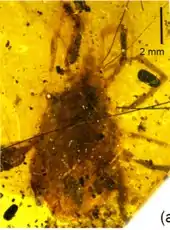 Immensmaris chewbaccei | |
|
Nothrotrombidium myanmarum[121] |
Konikiewicz & Mąkol |
2018 |
A trombellid mite. |
|
|
Odontoscirus cretacico[124] |
Porta et al. |
2020 |
A bdellid mite. |
|
|
Procaeculus coineaui[125] |
Porta et al. |
2019 |
A caeculid mite. |
|
Incertae sedis
| Taxon | Authority | Year described | Notes | image |
|---|---|---|---|---|
|
Wang et al |
2018 |
A tetrapulmonate of uncertain affinity |
 Chimerarachne yingi (artists reconstruction) | |
Callipodida
| Taxon | Authority | Year described | Notes | image |
|---|---|---|---|---|
|
Stoev, Moritz & Wesener |
2019 |
| ||
Platydesmida
| Taxon | Authority | Year described | Notes | image |
|---|---|---|---|---|
|
Andrognathus burmiticus[128] |
Moritz & Wesener |
2019 |
||
Polyxenida
| Taxon | Authority | Year described | Notes | image |
|---|---|---|---|---|
|
Pauropsxenus extraneus[129] |
Su, Cai & Huang |
2020 |
||
|
Pauropsxenus ordinatus[129] |
Su, Cai & Huang |
2020 |
||
|
Phryssonotus burmiticus[122] |
Cockerell |
1917 |
||
Siphoniulida
| Taxon | Authority | Year described | Notes | image |
|---|---|---|---|---|
|
Siphoniulus muelleri[130] |
Liu, Rühr & Wesener |
2017 |
||
|
Siphoniulus preciosus[130] |
Liu, Rühr & Wesener |
2017 |
||
Siphonophorida
| Taxon | Authority | Year described | Notes | image |
|---|---|---|---|---|
|
Siphonophora hui[131] |
Jiang et al. |
2020 |
A siphonophorid sucking millipede. |
|
Entomobryomorpha
| Taxon | Authority | Year described | Notes | image |
|---|---|---|---|---|
|
Burmisotoma lamellifera[132] |
Christiansen & Nascimbene |
2006 |
||
|
Cretacentomobrya burma[132] |
Christiansen & Nascimbene |
2006 |
||
|
Praentomobrya avita[132] |
Christiansen & Nascimbene |
2006 |
||
|
Proisotoma pettersonae[132] |
Christiansen & Nascimbene |
2006 |
||
|
Propachyotoma conica[132] |
Christiansen & Nascimbene |
2006 |
||
|
Protodesoria granda[132] |
Christiansen & Nascimbene |
2006 |
||
|
Protoisotoma burma[132] |
Christiansen & Nascimbene |
2006 |
||
|
Villusisotoma brevis[132] |
Christiansen & Nascimbene |
2006 |
||
|
Villusisotoma longa[132] |
Christiansen & Nascimbene |
2006 |
||
Poduromorpha
| Taxon | Authority | Year described | Notes | image |
|---|---|---|---|---|
|
Protodontella minicornis[132] |
Christiansen & Nascimbene |
2006 |
||
Symphypleona
| Taxon | Authority | Year described | Notes | image |
|---|---|---|---|---|
|
Grinnellia ventis[132] |
Christiansen & Nascimbene |
2006 |
||
|
Mucrovirga incompleta[132] |
Christiansen & Nascimbene |
2006 |
||
|
Sminthurconus grimaldi[132] |
Christiansen & Nascimbene |
2006 |
||
|
Sminthuricinus deceptus[132] |
Christiansen & Nascimbene |
2006 |
||
Insecta
Isopoda
| Taxon | Authority | Year described | Notes | image |
|---|---|---|---|---|
|
Myanmariscus deboiseae[133] |
Broly, Maillet & Ross |
2015 |
A possible styloniscid[134] woodlouse |
|
|
Palaeoarmadillo microsoma[134] |
Poinar |
2018 |
An armadillid woodlouse. |
|
Ostracoda
| Taxon | Authority | Year described | Notes |
|---|---|---|---|
|
Myanmarcypris hui[135] |
Wang et al. |
2020 |
A candonid ostracod. |
|
Sanyuania sp.[135] |
Wang et al. |
2020 |
A loxoconchid cytheroid. |
|
Thalassocypria sp.[135] |
Wang et al. |
2020 |
A candonid ostracod. |
Scolopendrellidae
| Taxon | Authority | Year described | Notes | image |
|---|---|---|---|---|
|
Symphylella patrickmuelleri[136] |
Moritz & Wesener |
2017 |
||
Mollusca
Ammonitida
| Taxon | Authority | Year described | Notes | image |
|---|---|---|---|---|
|
N/A |
"2019" |
An immature Puzosia (Bhimaites) species dead shell |
| |
"Architaenioglossa"
| Taxon | Authority | Year described | Notes | image |
|---|---|---|---|---|
|
Archaeocyclotus plicatula[138] |
Asato & Hirano in Hirano et al. |
2019 |
A cyclophorid land snail |
 Archaeocyclotus plicatula |
|
Balashov |
2020 |
A diplommatinid land snail |
||
|
Euthema hesoana[138] |
Asato & Hirano in Hirano et al. |
2019 |
A diplommatinid land snail |
 Euthema hesoana |
|
Balashov, Perkovsky & Vasilenko |
2020 |
A diplommatinid land snail |
||
|
Hirsuticyclus electrum[141] |
Neubauer, Xing & Jochum |
2019 |
A cyclophorid land snail |
|
|
Lagocheilus cretaspira[138] |
Asato & Hirano in Hirano et al. |
2019 |
A cyclophorid land snail |
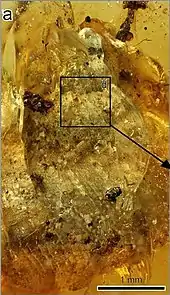 Lagocheilus cretaspira |
|
Lagocheilus electrospira[138] |
Asato & Hirano in Hirano et al. |
2019 |
A cyclophorid land snail |
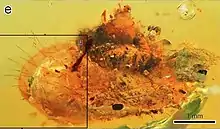 Lagocheilus electrospira |
|
(Yu, Wang & Jarzembowski) |
2019 |
A cyclophorid land snail, |
||
|
(Yu, Wang & Jarzembowski) |
2019 |
A cyclophorid land snail, |
||
|
Schistoloma electrothauma[138] |
Asato & Hirano in Hirano et al. |
2019 |
A pupinid land snail |
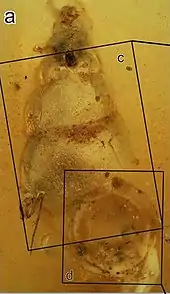 Schistoloma electrothauma |
Littorinimorpha
| Taxon | Authority | Year described | Notes | image |
|---|---|---|---|---|
|
Assiminea striatura[144] |
Bullis et al. |
2020 |
An assimineid land snail |
|
|
Eotrichophorus kachin[144] |
Bullis et al. |
2020 |
An assimineid land snail |
|
|
Macropupina electricus[144] |
Bullis et al. |
2020 |
An assimineid land snail |
|
|
Paleodiplommatina spelomphalos[144] |
Bullis et al. |
2020 |
An assimineid land snail |
|
|
Perissocyclos kyrtostoma[144] |
Bullis et al. |
2020 |
An assimineid land snail |
|
|
Xenostoma lophopleura[144] |
Bullis et al. |
2020 |
An assimineid land snail |
|
Mathildoidea
| Taxon | Authority | Year described | Notes | image |
|---|---|---|---|---|
|
N/A |
"2019" |
2 dead shells likely entombed as shoreline debris |
Neritimorpha
| Taxon | Authority | Year described | Notes | image |
|---|---|---|---|---|
|
?Hydrocena praecursor[145] |
Yu & Neubauer |
2021 |
A member of the family Hydrocenidae. |
Nematoda
Rhabditida
| Taxon | Authority | Year described | Notes | image |
|---|---|---|---|---|
|
Cretodiplogaster termitophilous[146] |
Poinar |
2011 |
A rhabditid nematode of uncertain placement |
|
|
Palaeocosmocerca burmanica[146] |
Poinar |
2011 |
A cosmocercid nematode |
|
|
Proheterorhabditis burmanicus[146] |
Poinar |
2011 |
A heterorhabditid nematode |
 Proheterorhabditis burmanicus next to host beetle |
Mermithida
| Taxon | Authority | Year described | Notes | image |
|---|---|---|---|---|
|
Cretacimermis aphidophilus[147] |
Poinar |
2017 |
||
|
Cretacimermis chironomae[146] |
Poinar |
2011 |
||
|
Cretacimermis protus[148] |
Poinar & Buckley |
2006 |
||
Aphelenchida
| Taxon | Authority | Year described | Notes | image |
|---|---|---|---|---|
|
Cretaciaphelenchoides burmensis[146] |
Poinar |
2011 |
An aphelenchoidid nematode |
|
Nematomorpha
Gordioidea
| Taxon | Authority | Year described | Notes | image |
|---|---|---|---|---|
|
Cretachordodes burmitis[148] |
Poinar & Buckley |
2006 |
A chordodid Gordian worm |
|
Onychophora
Euonychophora
| Taxon | Authority | Year described | Notes | image |
|---|---|---|---|---|
|
Engel & Grimaldi |
2002 |
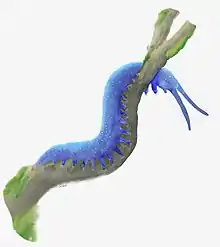 Cretoperipatus burmiticus (artist reconstruction) | ||
Vertebrata
Allocaudata
| Taxon | Authority | Year described | Notes | image |
|---|---|---|---|---|
|
Daza et al. |
2020 |
Figured in a 2016 as a Chameleonid. |
||
Anura
| Taxon | Authority | Year described | Notes | image |
|---|---|---|---|---|
|
Xing et al |
2018 |
A tropical frog |
| |
Archosauria
| Taxon | Authority | Year described | Notes | image |
|---|---|---|---|---|
|
Xing et al |
2016 |
Preserved tail with feathers |
||
|
Xing et al |
2019 |
An enantiornithine avialan, |
||
|
Multiple |
Various |
Several partial wings and feet, |
||
|
Xing et al. |
2020 |
A bee hummingbird sized saurian of uncertain placement. |
||
Squamata
| Taxon | Authority | Year described | Notes | image |
|---|---|---|---|---|
| Barlochersaurus winhtini[163] | Daza et al. | 2018 | A tiny (~ 2 cm long) possible stem-anguimorph | |
|
Arnold & Poinar |
2008 |
A gecko |
| |
|
Xiaophis myanmarensis[165] |
Xing et al. |
2018 |
||
| Squamata[149] | Daza et al. | 2016 | 13 Specimens of Squamate, varying from largely complete specimens to isolated limbs that were assigned to various families, one of which was later determined to be an albanerpetontid. | |
Ichnotaxa
Dictyoptera
| Ichnotaxon | Authority | Year described | Notes | image |
|---|---|---|---|---|
|
Blattocoprolites mesoblattamaxi[34] |
Hinkelman in Hinkelman & Vršanská |
2020 |
A mesoblattinid cockroach coprolite. |
|
Bivalvia
| Ichnotaxon | Authority | Year described | Notes | image |
|---|---|---|---|---|
|
Teredolites clavatus |
n/a |
2018 |
pholadid burrowing crypts in the amber nodules, |
 Teredolites clavatus |
References
- Ross, A.J. 2018. Burmese (Myanmar) amber taxa, on-line checklist v.2018.2 104pp
- Ross, A.J. 2019b. Burmese (Myanmar) amber taxa, on-line supplement v.2019.2. 33pp.
- Poinar, G. O. Jr; Vega, F. E. (2020). "Mid-Cretaceous cellular slime mold (Eukarya: Dictyostelia?) in Burmese amber". Historical Biology: An International Journal of Paleobiology. in press: 1–4. doi:10.1080/08912963.2019.1658095.
- Rikkinen, J.; Grimaldi, D. A.; Schmidt, A. R. (2019). "Morphological stasis in the first myxomycete from the Mesozoic, and the likely role of cryptobiosis". Scientific Reports. 9 (1): 19730. Bibcode:2019NatSR...919730R. doi:10.1038/s41598-019-55622-9. ISSN 2045-2322. PMC 6930221. PMID 31874965.
- Poinar, G. O. Jr. (2009). "Description of an early Cretaceous termite (Isoptera: Kalotermitidae) and its associated intestinal protozoa, with comments on their co-evolution". Parasites & Vectors. 2 (12): 1–17. doi:10.1186/1756-3305-2-12. PMC 2669471. PMID 19226475.
- Poinar, G. O. Jr.; Telford, S. R. (2005). "Paleohaemoproteus burmacis gen. n., sp. n. (Haemospororida: Plasmodiidae) from an Early Cretaceous biting midge (Diptera: Ceratopogonidae)". Parasitology. 131 (1): 79–84. doi:10.1017/S0031182005007298. PMID 16038399.
- Poinar, G. O. Jr. (2010). "Primigregarina burmanica n. gen., n. sp., an early cretaceous gregarine (Apicomplexa: Eugregarinorida) parasite of a cockroach (Insecta: Blattodea)". Fossil Behavior Compendium: 54–56.
- Poinar, G. O. Jr (2008). "Leptoconops nosopheris sp. n. (Diptera: Ceratopogonidae) and Paleotrypanosoma burmanicus gen. n., sp. n. (Kinetoplastida: Trypanosomatidae), a biting midge--trypanosome vector association from the Early Cretaceous". Memórias do Instituto Oswaldo Cruz. 103 (5): 468–71. doi:10.1590/s0074-02762008000500010. PMID 18797760.
- Poinar, G. O. Jr. (2009). "Early Cretaceous protist flagellates (Parabasalia: Hypermatigia: Oxymonada) of cockroaches (Insecta: Blattaria) in Burmese amber". Cretaceous Research. 30 (5): 1066–1072. doi:10.1016/j.cretres.2009.03.008.
- Poinar, G. O. Jr. (2016). "A mid-Cretaceous Eccrinales infesting a primitive wasp in Myanmar amber". Fungal Biology. 120 (12): 1537–1539. doi:10.1016/j.funbio.2016.08.001. PMID 27890089.
- Poinar, G. O. Jr. (2015). "Rickettsial-like cells in the Cretaceous tick, Cornupalpatum burmanicum (Ixodida: Ixodidae)". Cretaceous Research. 52, Part B: 623–627. doi:10.1016/j.cretres.2014.02.007.
- Poinar, G.; Chambers, K. L.; Buckley, R. (2007). "Eoëpigynia burmensis gen. and sp. nov., an Early Cretaceous eudicot flower (Angiospermae) in Burmese amber". Journal of the Botanical Research Institute of Texas: 91–96.
- Poinar, G. O. Jr (2017). "A mid-Cretaceous Lauraceae flower, Cascolaurus burmitis gen. et sp. nov., in Myanmar amber". Cretaceous Research. 71: 96–101. doi:10.1016/j.cretres.2016.11.015.
- Poinar, G. O. Jr.; Chambers, K. L. (2019). "Dispariflora robertae gen. et sp. nov., a mid-Cretaceous flower of possible Lauralean affinity from Myanmar amber". Journal of the Botanical Research Institute of Texas. 13 (1): 173–183.
- Crepet, W. L.; Nixon, K. C.; Grimaldi, D. A.; Riccio, M. (2016). "A mosaic Lauralean flower from the Early Cretaceous of Myanmar". American Journal of Botany. 103 (2): 290–297. doi:10.3732/ajb.1500393. PMID 26865118.
- Poinar, G. O. Jr; Chambers, K. L. (2005). "Palaeoanthella huangii gen. and sp. nov., an Early Cretaceous flower (Angiospermae) in Burmese amber". Sida. 21 (4): 2087–2092.
- Poinar, G. O. Jr; Chambers, K. L. (2019). "Zygadelphus aetheus gen. et sp. nov., an unusual fossil flower from mid-Cretaceous Myanmar amber". Journal of the Botanical Research Institute of Texas. 13 (2): 467–473.
- Peris, D.; Labandeira, C. C.; Barrón, E.; Delclòs, X.; Rust, J.; Wang, B. (2020). "Generalist pollen-feeding beetles during the mid-Cretaceous". iScience. 23 (3): Article 100913. doi:10.1016/j.isci.2020.100913. PMC 7113562. PMID 32191877.
- Poinar, G. O. Jr; Chambers, K. L. (2019). "Tropidogyne lobodisca sp. nov., a third species of the genus from mid-Cretaceous Myanmar amber". Journal of the Botanical Research Institute of Texas. 13 (2): 461–466.
- Poinar, G. O. Jr; Chambers, K. L. (2017). "Tropidogyne pentaptera, sp. nov., a new mid-Cretaceous fossil angiosperm flower in Burmese amber". Palaeodiversity. 10 (1): 135–140. doi:10.18476/pale.v10.a10.
- Chambers, K. L.; Poinar, G. O. Jr; Buckley, R. (2010). "Tropidogyne a new genus of Early Cretaceous eudicots (Angiospermae) from Burmese amber". Novon. 20 (1): 23–29. doi:10.3417/2008039. S2CID 86227328.
- Poinar, G. O. Jr (2004). "Programinis burmitis gen. et sp. nov., and P. laminatus sp. nov., Early Cretaceous grass-like monocots in Burmese amber". Australian Systematic Botany. 17 (5): 497–504. doi:10.1071/SB04002.
- Poinar, G. O. Jr.; Buckley, R.; Chen, H. (2016). "A primitive Mid-Cretaceous angiosperm flower, Antiquifloris latifibris gen. & sp. nov., in Myanmar amber". Journal of the Botanical Research Institute of Texas. 10 (1): 155–162.
- George Poinar, Jr. (2018). "Mid-Cretaceous angiosperm flowers in Myanmar amber". In Beatrice Welch; Micheal Wilkerson (eds.). Recent advances in plant research. pp. 187–218. ISBN 978-1-53614-170-2.
- Poinar, G. O. Jr (2019). "Exalloanthum, a new name for a fossil angiosperm flower in Myanmar amber". Journal of the Botanical Research Institute of Texas. 13 (2): 475–476.
- Poinar, G. O. Jr; Chambers, K. L.; Buckley, R. (2008). "An early Cretaceous angiosperm fossil of possible significance in rosid floral diversification". Journal of the Botanical Research Institute of Texas. 2 (2): 1183–1192.
- Liu, Z.-J.; Huang, D.; Cai, C.; Wang, X. (2018). "The core eudicot boom registered in Myanmar amber". Scientific Reports. 8 (1): Article number 16765. Bibcode:2018NatSR...816765L. doi:10.1038/s41598-018-35100-4. PMC 6233203. PMID 30425298.
- Poinar, G. O. Jr.; Chambers, K. L.; Wunderlich, J. (2013). "Micropetasos, a new genus of angiosperms from mid-cretaceous Burmese amber". Journal of the Botanical Research Institute of Texas. 7 (2): 745–750.
- Xing, L.; Gu, L. (2020). "The possible earliest epizoochorous fruit preserved in mid-Cretaceous Burmese amber". Cretaceous Research. 114: Article 104498. doi:10.1016/j.cretres.2020.104498.
- Poinar, G. O. Jr; Chambers, K. L. (2019). "Strombothelya gen. nov., a fossil angiosperm with two species in mid-Cretaceous Myanmar amber". Journal of the Botanical Research Institute of Texas. 13 (2): 451–460.
- Heinrichs, J.; Schäfer-Verwimp, A.; Hedenäs, L.; Ignatov, M. S.; Schmidt, A. R. (2014). "An acrocarpous moss in Cretaceous amber from Myanmar". Cretaceous Research. 51: 260–265. doi:10.1016/j.cretres.2014.06.010.
- Hedenäs, L.; Heinrichs, J.; Schmidt, A. R. (2014). "Bryophytes of the Burmese amber forest: amending and expanding the circumscription of the Cretaceous moss genus Vetiplanaxis". Review of Palaeobotany and Palynology. 209: 1–10. doi:10.1016/j.revpalbo.2014.05.008.
- Poinar, G. O. Jr.; Brown, A. e. (2020). "A green algae (Chaetophorales: Chaetophoraceae) in Burmese amber". Historical Biology: An International Journal of Paleobiology. in press: 1–5. doi:10.1080/08912963.2019.1616719.
- Hinkelman, J.; Vršanská, L. (2020). "A Myanmar amber cockroach with protruding feces contains pollen and a rich microcenosis". The Science of Nature. 107 (2): Article number 13. Bibcode:2020SciNa.107...13H. doi:10.1007/s00114-020-1669-y. PMID 32125545. S2CID 211730431.
- Heinrichs, J.; Reiner-Drewald, M.E.; Feldberg, K.; von Konrat, M.; Hentschel, J.; Váňa, J.; Grimaldi, D.A.; Nascimbene, P.C.; Schmidt, A.R. (2011). "The leafy liverwort Frullania (Jungermanniopsida) in the Cretaceous amber forest of Myanmar". Review of Palaeobotany and Palynology. 169: 21–28. doi:10.1016/j.revpalbo.2011.10.002.
- Hentschel, J.; Schmidt, A. R.; Heinrichs, J. (2009). "Frullania cretacea, sp. nov. (Porellales, Jungermanniopsida), a leafy liverwort preserved in Cretaceous amber from Myanmar". Cryptogamie, Bryologie. 30 (3): 323–328.
- Li, Y.; Wang, Y.-D.; Schnerder, H.; Wu, P.-C. (2020). "Frullania partita sp. nov. (Frullaniaceae, Porellales), a new leafy liverwort from the mid-Cretaceous of Myanmar". Cretaceous Research. 108: Article 104341. doi:10.1016/j.cretres.2019.104341.
- Heinrichs, J.; Feldberg, K.; Müller, P.; Schäfer-Verwimpe, A.; von Konrat, M.; Ilsemann, B; Krings, M. (2017). "Frullania pinnata spec. nov. (Frullaniaceae, Porellales), a new leafy liverwort in mid-Cretaceous Burmese amber from Myanmar". Cretaceous Research. 78: 56–60. doi:10.1016/j.cretres.2017.05.030.
- Heinrichs, J.; Schäfer-Verwimp, A.; Feldberg, K.; Schmidt, A. R. (2014). "The extant liverwort Gackstroemia (Lepidolaenaceae, Porellales) in Cretaceous amber from Myanmar". Review of Palaeobotany and Palynology. 203: 48–52. doi:10.1016/j.revpalbo.2014.01.004.
- Heinrichs, J.; Feldberg, K.; Bechteler, J.; Müller, P.; Renner, M. A.; Váňa, J.; Schäfer-Verwimp, A.; Schmidt, A. R. (2017). "A fossil genus of the Frullaniaceae (Porellales, Jungermanniopsida) from the mid-Cretaceous of Myanmar". Cretaceous Research. 74: 223–226. doi:10.1016/j.cretres.2017.02.023.
- Bechteler, J.; Schmidt, A. R.; Renner, M.A.; Wang, B.; Pérez-Escobar, O. A.; Schäfer-Verwimp, A.; Feldberg, K.; Heinrichs, J. (2017). "A Burmese amber fossil of Radula (Porellales, Jungermanniopsida) provides insights into the Cretaceous evolution of epiphytic lineages of leafy liverworts". Fossil Record. 20 (2): 201–213. doi:10.5194/fr-20-201-2017.
- Li, C.; Moran, R. C.; Ma, J.; Wang, B.; Hao, J.; Yang, Q. (2020). "A mid-Cretaceous tree fern of Thyrsopteridaceae (Cyatheales) preserved in Myanmar amber". Cretaceous Research. 105: Article 104050. doi:10.1016/j.cretres.2019.01.002.
- Poinar, G.O.Jr.; Buckley, R. (2008). "Cretacifilix fungiformis gen. and sp. nov., an eupolypod fern (Polypodiales) in Early Cretaceous Burmese amber". Journal of the Botanical Research Institute of Texas. 2 (2): 1175–1182.
- Regalado, L.; Schmidt, A. R.; Appelhans, M. S.; Ilsemann, B.; Schneider, H.; Krings, M.; Heinrichs, J. (2017). "A fossil species of the enigmatic early polypod fern genus Cystodium (Cystodiaceae) in Cretaceous amber from Myanmar". Scientific Reports. 7 (1): 1–9. Bibcode:2017NatSR...714615R. doi:10.1038/s41598-017-14985-7. PMC 5668433. PMID 29097728.
- Regalado, L.; Schmidt, A. R.; Müller, P.; Niedermeier, L.; Krings, M.; Schneider, H. (2019). "Heinrichsia cheilanthoides gen. et sp. nov., a fossil fern in the family Pteridaceae (Polypodiales) from the Cretaceous amber forests of Myanmar". Journal of Systematics and Evolution. 57 (4): 329–338. doi:10.1111/jse.12514.
- Regalado, L.; Schmidt, A. R.; Krings, M.; Bechteler, J.; Schneider, H.; Heinrichs, J. (2018). "Fossil evidence of eupolypod ferns in the mid-Cretaceous of Myanmar". Plant Systematics and Evolution. 304 (1): 1–13. doi:10.1007/s00606-017-1439-2. S2CID 21617872.
- Schneider, H.; Schmidt, A. R.; Heinrichs, J. (2016). "Burmese amber fossils bridge the gap in the Cretaceous record of polypod ferns". Perspectives in Plant Ecology, Evolution and Systematics. 18: 70–78. doi:10.1016/j.ppees.2016.01.003. hdl:10141/610456.
- Li, C.; Moran, R. C.; Ma, J.; Wang, B.; Hao, J. (2020). "A new fossil record of Lindsaeaceae (Polypodiales) from the mid-Cretaceous amber of Myanmar". Cretaceous Research. 105: Article 104040. doi:10.1016/j.cretres.2018.12.010.
- Poinar, G.O.; Buckley, R. (2007). "Evidence of mycoparasitism and hypermycoparasitism in Early Cretaceous amber". Mycological Research. 111 (4): 503–506. doi:10.1016/j.mycres.2007.02.004. PMID 17512712.
- Poinar, G. J.; Alderman, S.; Wunderlich, J. (2015). "One hundred million year old ergot: psychotropic compounds in the Cretaceous". Palaeodiversity. 8: 13–19.
- Sung, G. H.; Poinar, G. O.; Spatafora, J. W. (2008). "The oldest fossil evidence of animal parasitism by fungi supports a Cretaceous diversification of fungal–arthropod symbioses". Molecular Phylogenetics and Evolution. 49 (2): 495–502. doi:10.1016/j.ympev.2008.08.028. PMID 18817884.
- Poinar, G. O. Jr.; Vega, F. E. (2018). "A mid-Cretaceous ambrosia fungus, Paleoambrosia entomophila gen. nov. et sp. nov. (Ascomycota: Ophiostomatales) in Burmese (Myanmar) amber, and evidence for a femoral mycangium". Fungal Biology. 122 (12): 1159–1162. doi:10.1016/j.funbio.2018.08.002. PMID 30449353.
- Poinar Jr, G. O.; da Silva Alfredo, D.; Baseia, I. G. (2014). "A gasteroid fungus, Palaeogaster micromorpha gen. & sp. nov.(Boletales) in Cretaceous Myanmar amber". Journal of the Botanical Research Institute of Texas. 8 (1): 139–143.
- Poinar, G. O. (2018). "A mid-Cretaceous pycnidia, Palaeomycus epallelus gen. et sp. nov., in Myanmar amber". Historical Biology. 38: 1–4. doi:10.1080/08912963.2018.1446531. S2CID 90373037.
- "Spheciophila". www.mycobank.org. Retrieved 2020-02-26.
- Poinar, G. O. Jr; Vega, F. E. (2019). "A mid-Cretaceous trichomycete, Priscadvena corymbosa gen. et sp. nov., in Burmese amber". Fungal Biology. 123 (5): 393–396. doi:10.1016/j.funbio.2019.02.007. PMID 31053328.
- Salamon, M. A.; Lin, J.; Duda, P.; Gorzelak, P.; Ausich, W. I.; Oji, T. (2019). "Paleoenvironmental and biostratigraphic implications of echinoderm ossicles trapped within Burmese amber". PALAIOS. 34 (12): 652–656. Bibcode:2019Palai..34..652S. doi:10.2110/palo.2019.084. S2CID 209473464.
- Hu, X.; Lei, X.; Luo, C.; Jarzembowski, E.A.; Wang, B.; Xiao, C. (2020). "A new whip spider (Arachnida: Amblypygi) in mid-Cretaceous Kachin amber". Cretaceous Research. 116: Article 104596. doi:10.1016/j.cretres.2020.104596.
- Wunderlich, J. (2015). "New and rare fossil Arachnida in Cretaceous Burmese Amber (Amblypygi, Ricinulei and Uropygi: Thelephonida)" (PDF). In Jörg Wunderlich (ed.). Beiträge zur Araneologie, 9: Mesozoic spiders and other fossil arachnids. pp. 409–436.
- Engel, M.; Grimaldi, D. (2014). "Whipspiders (Arachnida: Amblypygi) in amber from the Early Eocene and mid-Cretaceous, including maternal care". Novitates Paleoentomologicae. 9: 1–17.
- Rossi, A.; Merendino, H. (2016). "Una nuova sottospecie di amblipigio dall'ambra birmana del Myanmar (Amblypygi)". Arachnida – Rivista Aracnologica Italiana. 9: 30–32.
- Wunderlich, J. (2017). "New and rare fossil spiders (Araneae) in mid Cretaceous amber from Myanmar (Burma), including the description of new extinct families of the suborders Mesothelae and Opisthothelae as well as notes on the taxonomy, the evolution and the biogeography of the Mesothelae" (PDF). In Jörg Wunderlich (ed.). Beiträge zur Araneologie, 10. pp. 72–279.
- Wunderlich, J.; Müller, P. (2020). "New and already described fossil spiders (Araneae) of 20 families in mid and Late Cretaceous Burmese ambers, with notes on spider phylogeny, evolution and classification" (PDF). In Jörg Wunderlich (ed.). Beiträge zur Araneologie, 13. pp. 22–164. ISBN 978-3-931473-19-8.
- Paul A. Selden; Dong Ren (2017). "A review of Burmese amber arachnids". Journal of Arachnology. 45 (3): 324–343. doi:10.1636/JoA-S-17-029. S2CID 90983791.
- Jörg Wunderlich; Patrick Müller (2018). "Reflections on the origin of the orb web, on the evolution and the relationships of selected spiders (Araneae): the RTA-clade, the superfamily Leptonetoidea as well as on the orb-weaving spiders (Araneoidea and Deinopoidea), based on "missing links" in Cretaceous Burmese amber; descriptions of new taxa, and notes on the spider fauna in Burmite" (PDF). In Jörg Wunderlich (ed.). Beiträge zur Araneologie, 11. Fossil spiders (Araneae) in Cretaceous Burmese amber. pp. 1–177. ISBN 978-3-931473-16-7.
- Wunderlich, J. (2015). "On the evolution and the classification of spiders, the Mesozoic spider faunas, and descriptions of new Cretaceous taxa mainly in amber from Myanmar (Burma) (Arachnida: Araneae)" (PDF). In Jörg Wunderlich (ed.). Beiträge zur Araneologie, 9: Mesozoic spiders and other fossil arachnids. pp. 21–408.
- Wunderlich, J. (2012). "On the fossil spider (Araneae) fauna in Cretaceous ambers, with descriptions of new taxa from Myanmar (Burma) and Jordan, and on the relationships of the superfamily Leptonetoidea" (PDF). In Jörg Wunderlich (ed.). Beiträge zur Araneologie, 7: Fifteen papers on extant and fossil spiders (Araneae). pp. 157–232.
- Penney, P. (2005). "The fossil spider family Lagonomegopidae". The Journal of Arachnology. 33: 439–444. doi:10.1636/04-55.1. S2CID 86341553.
- Wunderlich, J (2008). "The dominance of ancient spider families of the Araneae: Haplogynae in the Cretaceous, and the late diversification of the advanced ecribellate spiders of the Entelegynae after the Cretaceous-Tertiary boundary extinction events, with descriptions of new families". Beiträge zur Araneologie. 5: 524–674, 802–813.
- Wunderlich, J. (2011). "Some fossil spiders (Araneae) in Cretaceous ambers". In Jörg Wunderlich (ed.). Beiträge zur Araneologie, 6. pp. 539–557.
- Selden, P. A.; Zhang, W.; Ren, D. (2016). "A bizarre armoured spider (Araneae: Tetrablemmidae) from Upper Cretaceous Myanmar amber". Cretaceous Research. 66: 129–135. doi:10.1016/j.cretres.2016.06.007.
- Wunderlich, J. (2019). "What is a spider? Cretaceous fossils modify strongly phylogenetics as well as diagnoses of families, superfamilies and even suborders of spiders (Araneida) and other arthropods" (PDF). In Jörg Wunderlich (ed.). Beiträge zur Araneologie, 12. pp. 1–32.
- The world spider catalog-Fossils
- Poinar, G. O. Jr.; Buckley, R. (2012). "Predatory behaviour of the social orb-weaver spider, Geratonephila burmanica n. gen., n. sp. (Araneae: Nephilidae) with its wasp prey, Cascoscelio incassus n. gen., n. sp. (Hymenoptera: Platygastridae) in Early Cretaceous Burmese amber". Historical Biology. 24 (5): 519–525. doi:10.1080/08912963.2011.640399. S2CID 86838688.
- Guo, X.; Selden, P. A.; Shih, C.; Ren, D. (2020). "Two new lagonomegopid spiders (Arachnida: Araneae) from the mid-Cretaceous of northern Myanmar, with comments on the superfamilial placement of Lagonomegopidae". Cretaceous Research. 106: Article 104257. doi:10.1016/j.cretres.2019.104257.
- Penny, D. (2004). "A new genus and species of Pisauridae (Araneae) in Cretaceous Burmese amber". Journal of Systematic Palaeontology. 2 (2): 141–145. doi:10.1017/S147720190400121X. S2CID 84354469.
- Magalhaes, I. L. F.; Porta, A .O.; Wunderlich, J.; Proud, D. N.; Ramírez, M. J.; Pérez-González, A. (2021). "Taxonomic revision of fossil Psilodercidae and Ochyroceratidae spiders (Araneae: Synspermiata), with a new species of Priscaleclercera from mid-Cretaceous Burmese amber, northern Myanmar". Cretaceous Research. in press: Article 104751. doi:10.1016/j.cretres.2020.104751.
- Chitimia-Dobler, L.; Cancian de Araujo, B.; Ruthensteiner, B.; Pfeffer, T.; Dunlop, J. (2017). "Amblyomma birmitum a new species of hard tick in Burmese amber". Parasitology. 144 (11): 1441–1448. doi:10.1017/S0031182017000853. PMID 28583219.
- Poinar, G.; Brown, A. E. (2003). "A new genus of hard ticks in Cretaceous Burmese amber (Acari: Ixodida: Ixodidae)". Systematic Parasitology. 54 (3): 199–205. doi:10.1023/A:1022689325158. PMID 12652071. S2CID 11527194.
- Peñalver, Enrique; Arillo, Antonio; Delclòs, Xavier; Peris, David; Grimaldi, David A.; Anderson, Scott R.; Nascimbene, Paul C.; Pérez-de la Fuente, Ricardo (2017-12-12). "Ticks parasitised feathered dinosaurs as revealed by Cretaceous amber assemblages". Nature Communications. 8 (1): 1924. doi:10.1038/s41467-017-01550-z. ISSN 2041-1723. PMC 5727220. PMID 29233973.
- Chitimia-Dobler, L.; Pfeffer, T.; Dunlop, J. A. (2018). "Haemaphysalis cretacea a nymph of a new species of hard tick in Burmese amber". Parasitology. 145 (11): 1440–1451. doi:10.1017/S0031182018000537. PMID 29642954.
- Dunlop, J.; de Oliveira Bernardi, L. (2014). "An opilioacarid mite in Cretaceous Burmese amber". Naturwissenschaften. 101 (9): 759–763. doi:10.1007/s00114-014-1212-0. PMID 25027588. S2CID 11712907.
- Bartel, C.; Dunlop, J. A.; Sharma, P. P.; Selden, P. A.; Ren, D.; Shih, C. (2020). "Laniatorean harvestmen (Arachnida: Opiliones) from mid-Cretaceous Burmese amber". Cretaceous Research. 119: Article 104703. doi:10.1016/j.cretres.2020.104703.
- Giribet, G.; Dunlop, J. (2005). "First identifiable Mesozoic harvestman (Opiliones: Dyspnoi) from Cretaceous Burmese amber" (PDF). Proceedings of the Royal Society B. 272 (1567): 1007–1013. doi:10.1098/rspb.2005.3063. PMC 1039256. PMID 1599874.
- Wunderlich, J. (2017). "New extinct taxa of the arachnid order Ricinulei, based on new fossils preserved in mid Cretaceous Burmese amber" (PDF). In Jörg Wunderlich (ed.). Beiträge zur Araneologie, 10. pp. 48–71.
- Poinar, G. O. Jr (2008). "Palaeosiro burmanicum n. gen., n. sp., a fossil Cyphophthalmi (Arachnida: Opiliones: Sironidae) in early Cretaceous Burmese amber". Advances in Arachnology and Developmental Biology. Papers Dedicated to Prof. Dr. Božidar Ćurčić. 12: 267–274.
- Selden, P. A.; Dunlop, J. A.; Giribet, G.; Zhang, W.; Ren, D. (2016). "The oldest armoured harvestman (Arachnida: Opiliones: Laniatores), from Upper Cretaceous Myanmar amber". Cretaceous Research. 65: 206–212. doi:10.1016/j.cretres.2016.05.004.
- Engel, M. S.; Breitkreuz, L. C. V.; Cai, C.; Alvarado, M.; Azar, D.; Huang, D. (15 February 2016). "The first Mesozoic microwhip scorpion (Palpigradi): a new genus and species in mid-Cretaceous amber from Myanmar". The Science of Nature. 103 (3–4): 19. Bibcode:2016SciNa.103...19E. doi:10.1007/s00114-016-1345-4. PMID 26879963. S2CID 14816297.
- Cockerell, T. D. A. (1920). "Fossil arthropods in the British Museum - I. The Annals and Magazine of Natural History, Ninth Series". 5: 273–279. Cite journal requires
|journal=(help) - Cockerell, T. D. A. (1917). "Arthropods in Burmese amber". American Journal of Science, Series 4. 44 (263): 360–368. Bibcode:1917AmJS...44..360C. doi:10.2475/ajs.s4-44.263.360.
- Porta, A. O.; Michalik, P.; Franchi, E.; Proud, D. N. (2020). "The first fossil pycnocheiridiine pseudoscorpion (Pseudoscorpiones: Cheiridiidae: Procheiridium gen. nov.) from Cretaceous Burmese amber". Zootaxa. 4801 (1): 142–150. doi:10.11646/zootaxa.4801.1.6. PMID 33056675.
- Henderickx, H.; Boone, M. (2016). "The basal pseudoscorpion family Feaellidae Ellingsen, 1906 walks the Earth for 98.000.000 years: a new fossil genus has been found in Cretaceous Burmese amber (Pseudoscorpiones: Feaellidae)". Entomo-Info. 27 (1): 7–12.
- Wolfe, J. M.; Daley, A. C.; Legg, D. A.; Edgecombe, G. D. (2016). "Fossil calibrations for the arthropod Tree of Life". Earth-Science Reviews. 160: 43–110. Bibcode:2016ESRv..160...43W. doi:10.1016/j.earscirev.2016.06.008.
- Harvey, M. S.; Cosgrove, J .G.; Harms, D.; Selden, P. A.; Shih, C.; Wang, C. (2018). "The oldest chthonioid pseudoscorpion Arachnida: Pseudoscorpiones: Chthonioidea: Chthoniidae: A new genus and species from mid-Cretaceous Burmese amber". Zoologischer Anzeiger. 273: 102–111. doi:10.1016/j.jcz.2017.12.009.
- Wunderlich, J. (2012). "Description of the first fossil Ricinulei in amber from Burma (Myanmar), the first report of this arachnid order from the Mesozoic and from Asia, with notes on the related extinct order Trigonotarbida" (PDF). In Jörg Wunderlich (ed.). Beiträge zur Araneologie, 7: Fifteen papers on extant and fossil spiders (Araneae). pp. 233–244.
- Müller, S. P.; Dunlop, J. A.; Kotthoff, U.; Hammel, J. U.; Harms, D. (2020). "The oldest short-tailed whipscorpion (Schizomida): a new genus and species from the Upper Cretaceous amber of northern Myanmar". Cretaceous Research. 106: Article 104227. doi:10.1016/j.cretres.2019.104227.
- Lourenço, W. R.; Velten, J. (2016). "A new genus and species of fossil scorpion from Burmese Cretaceous amber (Scorpiones: Buthoidea: Buthidae)". Arachnida – Rivista Aracnologica Italiana. 10: 2–9.
- Lourenço, W. (2015). "A new subfamily, genus and species of fossil scorpions from Cretaceous Burmese amber (Scorpiones: Palaeoeuscorpiidae)" (PDF). In Jörg Wunderlich (ed.). Beiträge zur Araneologie, 9: Mesozoic spiders and other fossil arachnids. pp. 457–464.
- Lourenço, W. R. (2016). "A preliminary synopsis on amber scorpions with special reference to Burmite species: an extraordinary development of our knowledge in only 20 years". ZooKeys (600): 75–87. doi:10.3897/zookeys.600.8913. PMC 4926682. PMID 27408601.
- Lourenço, W. (2015). "New contribution to the knowledge of Cretaceous Burmese amber scorpions: descriptions of two new species of Betaburmesebuthus Lourenço, 2015 (Scorpiones: Archaeobuthidae: Palaeoburmesebuthinae)". Arachnida – Rivista Aracnologica Italiana. 3: 27–36.
- Lourenço, W. R.; Velten, J. (2016). "One more new species of Betaburmesebuthus Lourenço, 2015 (Scorpiones: Palaeoburmesebuthinae) from Cretaceous burmite". Arachnida – Rivista Aracnologica Italiana. 6: 4–11.
- Lourenço, W.; Rossi, A. (2017). "Two more new species of Burmese amber scorpions of the family Palaeoburmesebuthidae Lourenço, 2015 (Scorpiones)". Arachnida – Rivista Aracnologica Italiana. 13: 11–21.
- Lourenço, W.; Beigel, A. (2015). "A new genus and species of Palaeoburmesebuthinae Lourenço, 2015 (Scorpiones: Archaeobuthidae) from Cretaceous amber of Burmese" (PDF). In Jörg Wunderlich (ed.). Beiträge zur Araneologie, 9: Mesozoic spiders and other fossil arachnids. pp. 476–480.
- Lourenço, W. R.; Velten, J. (2016). "A sixth new species of Cretaceous Burmese amber scorpion of the genus Betaburmesebuthus Lourenço, 2015 (Scorpiones: Palaeoburmesebuthidae)". Arachnida – Rivista Aracnologica Italiana. 10: 10–17.
- Lourenço, W. R. (2016). "A new genus and three new species of scorpions from Cretaceous Burmese amber (Scorpiones: Chaerilobuthidae: Palaeoeuscorpiidae)". Arthropoda Selecta. 25 (1): 67–74. doi:10.15298/arthsel.25.1.06.
- Lourenço, W. (2015). "Clarification of the familiar status of the genus Palaeoburmesebuthus Lourenço, 2002 from Cretaceous Burmese amber (Scorpiones: Archaeobuthidae: Palaeoburmesebuthinae)" (PDF). In Jörg Wunderlich (ed.). Beiträge zur Araneologie, 9: Mesozoic spiders and other fossil arachnids. pp. 465–475.
- Lourenço, W.; Beigel, A. (2011). "A new scorpion fossil from the Cretaceous amber of Myanmar (Burma). New phylogenetic implications". Comptes Rendus Palevol. 10 (8): 635–639. doi:10.1016/j.crpv.2011.08.001.
- Lourenço, W. (2015). "An unusual new species of Chaerilobuthus Lourenço & Beigel, 2011 (Scorpiones: Chaerilobuthidae) from the Cretaceous amber of Myanmar (Burma)". Arachnida – Rivista Aracnologica Italiana. 5: 44–48.
- Lourenço, W. R. (2018). "Further data on the genus Chaerilobuthus Lourenço et Beigel, 2011 (Scorpiones: Chaerilobuthidae) from Cretaceous Burmite and description of a new species". Arachnida – Rivista Aracnologica Italiana. 19: 2–13.
- Lourenço, W. (2013). "A new species of Chaerilobuthus Lourenço & Beigel, 2011 from Cretaceous Burmese amber (Scorpiones: Chaerilobuthidae)". Acta Biológica Paranaense. 42 (1–4): 1–5. doi:10.5380/abpr.v42i1-4.35095.
- Lourenço, W.; Velten, J. (2015). "Another new species of Chaerilobuthus Lourenço & Beigel, 2011 (Scorpiones: Chaerilobuthidae) from the Cretaceous amber of Myanmar (Burma)". Arachnida – Rivista Aracnologica Italiana. 5: 2–8.
- Lourenço, W. R. (2018). "A new remarkable scorpion genus and species from Cretaceous Burmese amber (Scorpiones: Protoischnuridae)". Arachnida – Rivista Aracnologica Italiana. 18: 2–14.
- Santiago-Blay, J. A.; Fet, V.; Soleglad, M. E.; Anderson, S. (2004). "A new genus and subfamily of scorpions from Cretaceous Burmese amber (Scorpiones: Chaerilidae)". Revista Ibérica de Aracnología. 9: 3–14.
- Lourenço, W. (2002). "The first scorpion fossil from the Cretaceous amber of Myanmar (Burma). New implications for the phylogeny of Buthoidea". Comptes Rendus Palevol. 1 (2): 97–101. doi:10.1016/S1631-0683(02)00017-9.
- Lourenço, W. R. (2018). "A further new species of Palaeoburmesebuthus Lourenço, 2002 from burmite (Scorpiones: Palaeoburmesebuthidae)". Revista Ibérica de Aracnología. 32: 51–54.
- Lourenço, W. (2012). "About the scorpion fossils from the Cretaceous amber of Myanmar (Burma) with the descriptions of a new family, genus and species". Acta Biológica Paranaense. 41 (3–4): 75–87.
- Lourenço, W.; Velten, J. (2017). "One more new genus and species of fossil scorpion from Burmese Cretaceous amber belonging to the family Palaeoburmesebuthidae (Scorpiones)". Arachnida – Rivista Aracnologica Italiana. 13: 2–10.
- Rossi, A. (2015). "A new family, genus and species of scorpion from the burmite of Burmese amber (Scorpiones: Sucinlourencoidae)". Arachnida – Rivista Aracnologica Italiana. 1: 3–21.
- Dunlop, J.; Bird, T.; Brookhart, J.; Bechly, G. (2015). "A camel spider from Cretaceous Burmese amber". Cretaceous Research. 56: 265–273. doi:10.1016/j.cretres.2015.05.003.
- Cai, C.; Huang, D. (2017). "A new genus of whip-scorpions in Upper Cretaceous Burmese amber: Earliest fossil record of the extant subfamily Thelyphoninae (Arachnida: Thelyphonida: Thelyphonidae)". Cretaceous Research. 69: 100–105. doi:10.1016/j.cretres.2016.09.004.
- Konikiewicz, M.; Mąkol, J. (2018). "Insight into fossil fauna of terrestrial Parasitengona mites (Trombidiformes: Prostigmata) – The first representatives of Erythraeina Welbourn, 1991 and Trombidiina Welbourn, 1991 in Burmese amber". Cretaceous Research. 89: 60–74. doi:10.1016/j.cretres.2018.02.017.
- Cockerell, T. D. A. (1917). "Arthropods in Burmese amber". Psyche. 24 (263): 40–44. Bibcode:1917AmJS...44..360C. doi:10.1155/1917/83242.
- Dunlop, J. A.; Frahnert, K.; Mąkol, J. (2018). "A giant mite in Cretaceous Burmese amber". Fossil Record. 21 (2): 285–290. doi:10.5194/fr-21-285-2018.
- Porta, A. O.; Proud, D. N.; Michalik, P.; Hernandes, F. A. (2020). "Notes on fossil Bdelloidea 1: the first snout mite (Acariformes: Bdellidae: Odontoscirinae) from the Cretaceous amber of Myanmar". Systematic and Applied Acarology. 25 (10): 1754–1764. doi:10.11158/saa.25.10.4.
- Porta, A. O.; Proud, D. N.; Franchi, E.; Porto, W.; Bernarda Epele, M.; Michalik, P. (2019). "The first record of caeculid mites from the Cretaceous amber of Myanmar with notes on the phylogeny of the family". Zootaxa. 4647 (1): 23–43. doi:10.11646/zootaxa.4647.1.5. PMID 31716973.
- Wang, B.; Dunlop, J. A.; Selden, P. A.; Garwood, R. J.; Shear, W. A.; Müller, P.; Lei, X. (2018). "Cretaceous arachnid Chimerarachne yingi gen. et sp. nov. illuminates spider origins". Nature Ecology & Evolution. 2 (4): 614–622. doi:10.1038/s41559-017-0449-3. ISSN 2397-334X. PMID 29403075. S2CID 4239867.
- Stoev, P.; Moritz, L.; Wesener, T. (2019). "Dwarfs under dinosaur legs: a new millipede of the order Callipodida (Diplopoda) from Cretaceous amber of Burma". ZooKeys (841): 79–96. doi:10.3897/zookeys.841.34991. ISSN 1313-2970. PMC 6529722. PMID 31148918.
- Moritz, L.; Wesener, T. (2019). "The first known fossils of the Platydesmida—an extant American genus in Cretaceous amber from Myanmar (Diplopoda: Platydesmida: Andrognathidae)". Organisms Diversity & Evolution. 19 (3): 423–433. doi:10.1007/s13127-019-00408-0. S2CID 195744191.
- Su, Y.; Cai, C.; Huang, D. (2020). "Two new species of the bristle millipede genus Pauropsxenus (Diplopoda, Polyxenidae) in mid-Cretaceous Burmese amber". Cretaceous Research. 111: Article 104427. doi:10.1016/j.cretres.2020.104427.
- Liu, W.; Rühr, P. T.; Wesener, T. (2017). "A look with μCT technology into a treasure trove of fossils: The first two fossils of the millipede order Siphoniulida discovered in Cretaceous Burmese amber (Myriapoda, Diplopoda)". Cretaceous Research. 74: 100–108. doi:10.1016/j.cretres.2017.01.009.
- Jiang, X.; Shear, W. A.; Hennen, D. A.; Chen, H.; Xie, X. (2019). "One hundred million years of stasis: Siphonophora hui sp. nov., the first Mesozoic sucking millipede (Diplopoda: Siphonophorida) from mid-Cretaceous Burmese amber". Cretaceous Research. 97: 34–39. doi:10.1016/j.cretres.2019.01.011.
- Christiansen, K.; Nascimbene, P. (2006). "Collembola (Arthropoda, Hexapoda) from the mid Cretaceous of Myanmar (Burma)". Cretaceous Research. 27 (3): 318–363. doi:10.1016/j.cretres.2005.07.003.
- Broly, P.; Maillet, S.; Ross, A. J. (2015). "The first terrestrial isopod (Crustacea: Isopoda: Oniscidea) from Cretaceous Burmese amber of Myanmar". Cretaceous Research. 55: 220–228. doi:10.1016/j.cretres.2015.02.012.
- Poinar, G. O. Jr. (2018). "A new genus of terrestrial isopods (Crustacea: Oniscidea: Armadillidae) in Myanmar amber". Historical Biology: An International Journal of Paleobiology. Online edition (5): 1–6. doi:10.1080/08912963.2018.1509964. S2CID 91494413.
- Wang, H.; Matzke-Karasz, R.; Horne, D. J.; Zhao, X.; Cao, M.; Zhang, H.; Wang, B. (2020). "Exceptional preservation of reproductive organs and giant sperm in Cretaceous ostracods". Proceedings of the Royal Society B: Biological Sciences. 287 (1935): Article ID 20201661. doi:10.1098/rspb.2020.1661. PMID 32933445. S2CID 221714233.
- Moritz, L.; Wesener, T. (2017). "Symphylella patrickmuelleri sp. nov. (Myriapoda: Symphyla): The oldest known Symphyla and first fossil record of Scolopendrellidae from Cretaceous Burmese amber". Cretaceous Research. 84: 258–263. doi:10.1016/j.cretres.2017.11.018.
- Yu, T.; Kelly, R.; Mu, L; Ross, A.; Kennedy, J.; Broly, P.; Xia, F.; Zhang, H.; Wang, B.; Dilcher, D. (2019-06-04). "An ammonite trapped in Burmese amber". Proceedings of the National Academy of Sciences. 116 (23): 11345–11350. doi:10.1073/pnas.1821292116. ISSN 0027-8424. PMC 6561253. PMID 31085633.
- Hirano, T.; Asato, K.; Yamamoto, S.; Takahashi, Y.; Chiba, S. (2019). "Cretaceous amber fossils highlight the evolutionary history and morphological conservatism of land snails". Scientific Reports. 9 (1): Article number 15886. Bibcode:2019NatSR...915886H. doi:10.1038/s41598-019-51840-3. PMC 6828811. PMID 31685840.
- Balashov, I. A. (2020). "An inventory of molluscs recorded from mid-Cretaceous Burmese amber, with the description of a land snail, Euthema annae sp. nov. (Caenogastropoda, Cyclophoroidea, Diplommatinidae)". Cretaceous Research. 118: Article 104676. doi:10.1016/j.cretres.2020.104676.
- Balashov, I. A.; Perkovsky, E. E.; Vasilenko, D. V. (2020). "A mid-Cretaceous land snail Euthema truncatellina sp. nov. (Caenogastropoda, Cyclophoroidea, Diplommatinidae) from Burmese amber". Zootaxa. 4858 (2): 295–300. doi:10.11646/zootaxa.4858.2.11. PMID 33056238.
- Neubauer, T. A.; Xing, L.; Jochum, A. (2019). "Land snail with periostracal hairs preserved in Burmese amber". iScience. 20: 567–574. doi:10.1016/j.isci.2019.09.034. PMC 6834951. PMID 31611056.
- Yu, T.-T.; Wang, B.; Jarzembowski, E. (2019). "First record of marine gastropods (wentletraps) from mid-Cretaceous Burmese amber". Palaeoworld. 28 (4): 508–513. doi:10.1016/j.palwor.2018.12.004.
- Neubauer, T. A.; Páll-Gergely, B.; Jochum, A.; Harzhauser, M. (2019). "Striking case of convergence — alleged marine gastropods in Cretaceous Burmese amber are terrestrial cyclophoroids. Comment on Yu et al". Palaeoworld. 28 (4): 572–575. doi:10.1016/j.palwor.2019.05.015.
- Bullis, D. A.; Herhold, H. W.; Czekanski-Moir, J. E.; Grimaldi, D. A.; Rundell, R. J. (2020). "Diverse new tropical land snail species from mid-Cretaceous Burmese amber (Mollusca: Gastropoda: Cyclophoroidea, Assimineidae)". Cretaceous Research. 107: Article 104267. doi:10.1016/j.cretres.2019.104267.
- Yu, T.; Neubauer, T. A. (2021). "The oldest fossil Hydrocenidae found in mid-Cretaceous Burmese amber (Gastropoda: Cycloneritida)". Cretaceous Research. in press: Article 104765. doi:10.1016/j.cretres.2021.104765.
- Poinar, G.O. (2011). "The Evolutionary History of Nematodes: As Revealed in Stone, Amber and Mummies". Nematology Monographs and Perspectives Pages. 9: 91–93, 239–240, 324–325.
- Poinar, G. O. Jr. (2017). "A mermithid nematode, Cretacimermis aphidophilus sp. n. (Nematoda: Mermithidae), parasitising an aphid (Hemiptera: Burmitaphididae) in Myanmar amber: a 100 million year association". Nematology. 19 (5): 509–513. doi:10.1163/15685411-00003063.
- Poinar, G. O. Jr.; Buckley, R. (2006). "Nematode (Nematoda: Mermithidae) and hairworm (Nematomorpha: Chordodidae) parasites in Early Cretaceous amber". Journal of Invertebrate Pathology. 93 (1): 36–41. doi:10.1016/j.jip.2006.04.006. PMID 16737709.
- Daza, Juan D.; Stanley, Edward L.; Wagner, Philipp; Bauer, Aaron M.; Grimaldi, David A. (4 March 2016). "Mid-Cretaceous amber fossils illuminate the past diversity of tropical lizards". Science Advances. 2 (3): e1501080. doi:10.1126/sciadv.1501080. ISSN 2375-2548. PMC 4783129. PMID 26973870.
- Matsumoto, R.; Evans, S. E. (2018). "The first record of albanerpetontid amphibians (Amphibia: Albanerpetontidae) from East Asia". PLOS ONE. 13 (1): e0189767. Bibcode:2018PLoSO..1389767M. doi:10.1371/journal.pone.0189767. ISSN 1932-6203. PMC 5752013. PMID 29298317.
- Daza, J. D.; Stanley, E. L.; Bolet, A.; Bauer, A. M.; Arias, J. S.; Čerňanský, A.; Bevitt, J. J.; Wagner, P.; Evans, S. E. (2020). "Enigmatic amphibians in mid-Cretaceous amber were chameleon-like ballistic feeders". Science. 370 (6517): 687–691. doi:10.1126/science.abb6005.
- Xing, L.; Stanley, E. L.; Bai, M.; Blackburn, D. C. (2018). "The earliest direct evidence of frogs in wet tropical forests from Cretaceous Burmese amber". Scientific Reports. 8 (1): Article number: 8770. Bibcode:2018NatSR...8.8770X. doi:10.1038/s41598-018-26848-w. PMC 6002357. PMID 29904068.
- Xing, L.; McKellar, R. C.; Xu, X.; Li, G.; Bai, M.; Persons, W. S.; Miyashita, T.; Benton, M. J.; Zhang, J.; Wolfe, A. P.; Yi, Q.; Tseng, K.; Ran, H.; Currie, P.J. (2016). "A feathered dinosaur tail with primitive plumage trapped in mid-Cretaceous amber". Current Biology. 26 (24): 3352–3360. doi:10.1016/j.cub.2016.10.008. PMID 27939315.
- Xing, L.; O’Connor, J. K.; Chiappe, L. M.; McKellar, R. C.; Carroll, N.; Hu, H.; Bai, M.; Lei, F. (2019). "A New Enantiornithine Bird with Unusual Pedal Proportions Found in Amber". Current Biology. 29 (14): 2396–2401. doi:10.1016/j.cub.2019.05.077. PMID 31303484.
- Xing, L.; McKellar, R. C.; Wang, M.; Bai, M.; O’Connor, J. K.; Benton, M. J.; Zhang, J.; Wang, Y.; Tseng, K.; Lockley, M. G.; Li, G.; Zhang, W.; Xu, X. (2016). "Mummified precocial bird wings in mid-Cretaceous Burmese amber". Nature Communications. 7: Article number 12089. Bibcode:2016NatCo...712089X. doi:10.1038/ncomms12089. PMC 4931330. PMID 27352215.
- Xing, L.; O'Connor, J. K.; McKellar, R. C.; Chiappe, L. M.; Tseng, K.; Li, G.; Bai, M. (2017). "A mid-Cretaceous enantiornithine (Aves) hatchling preserved in Burmese amber with unusual plumage". Gondwana Research. 49: 264–277. Bibcode:2017GondR..49..264X. doi:10.1016/j.gr.2017.06.001.
- Xing, L.; O'Connor, J. K.; McKellar, R. C.; Chiappe, L. M.; Bai, M.; Tseng, K.; Zhang, J.; Yang, H.; Fang, J.; Li, G. (2018). "A flattened enantiornithine in mid-Cretaceous Burmese amber: morphology and preservation". Science Bulletin. 63 (4): 235–243. doi:10.1016/j.scib.2018.01.019.
- Xing, L.; McKellar, R. C.; O'Connor, J.; Bai, M.; Tseng, K.; Chiappe, L. M. (2019). "A fully feathered enantiornithine foot and wing fragment preserved in mid-Cretaceous Burmese amber". Scientific Reports. 9 (1): Article number 927. Bibcode:2019NatSR...9..927X. doi:10.1038/s41598-018-37427-4. PMC 6353931. PMID 30700773.
- Xing, L.; McKellar, R. C.; O’Connor, J. K.; Niu, K.; Mai, H. (2019). "A mid-Cretaceous enantiornithine foot and tail feather preserved in Burmese amber". Scientific Reports. 9 (1): Article number 15513. Bibcode:2019NatSR...915513X. doi:10.1038/s41598-019-51929-9. PMC 6820775. PMID 31664115.
- Xing, L.; McKellar, R. C.; O'Connor, J. K. (2020). "An unusually large bird wing in mid-Cretaceous Burmese amber". Cretaceous Research. 110: Article 104412. doi:10.1016/j.cretres.2020.104412.
- Xing, L.; Cockx, P.; O'Connor, J. K.; McKellar, R. C. (2020). "A newly discovered enantiornithine foot preserved in mid-Cretaceous Burmese amber". Palaeoentomology. 3 (2): 212–219. doi:10.11646/palaeoentomology.3.2.11.
- Xing, L.; O’Connor, J. K.; Schmitz, L.; Chiappe, L. M.; McKellar, R. C.; Yi, Q.; Li, G. (2020). "Hummingbird-sized dinosaur from the Cretaceous period of Myanmar". Nature. 579 (7798): 245–249. doi:10.1038/s41586-020-2068-4. PMID 32161388. S2CID 212670113.
- Daza, J. D.; Bauer, A. M.; Stanley, E. L.; Bolet, A.; Dickson, B.; Losos, J. B. (2018-11-01). "An Enigmatic Miniaturized and Attenuate Whole Lizard from the Mid-Cretaceous Amber of Myanmar" (PDF). Breviora. 563 (1): 1. doi:10.3099/mcz49.1. ISSN 0006-9698.
- Arnold, E.N.; Poinar, G. O. Jr. (2008). "A 100 million year old gecko with sophisticated adhesive toe pads, preserved in amber from Myanmar (abstract)" (PDF). Zootaxa. doi:10.11646/zootaxa.1847.1.5.
- Xing, L.; Caldwell, M. W.; Chen, R.; Nydam, R. L.; Palci, A.; Simões, T.R.; McKellar, R. C.; Lee, M. S. Y.; Liu, Y.; Shi, H.; Wang, K.; Bai, M. (2018). "A mid-Cretaceous embryonic-to-neonate snake in amber from Myanmar". Science Advances. 4 (7): eaat5042. Bibcode:2018SciA....4.5042X. doi:10.1126/sciadv.aat5042. PMC 6051735. PMID 30035227.
